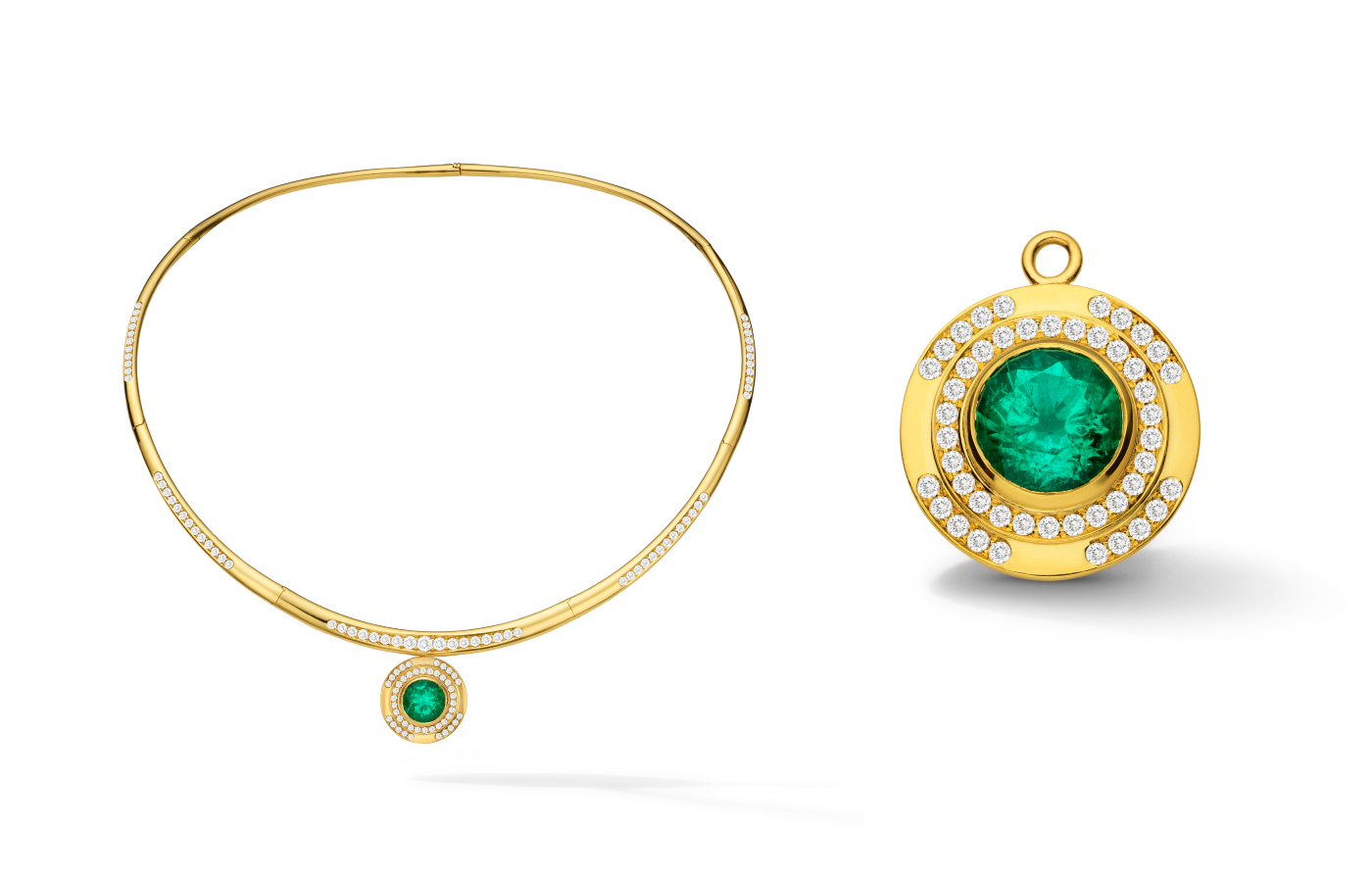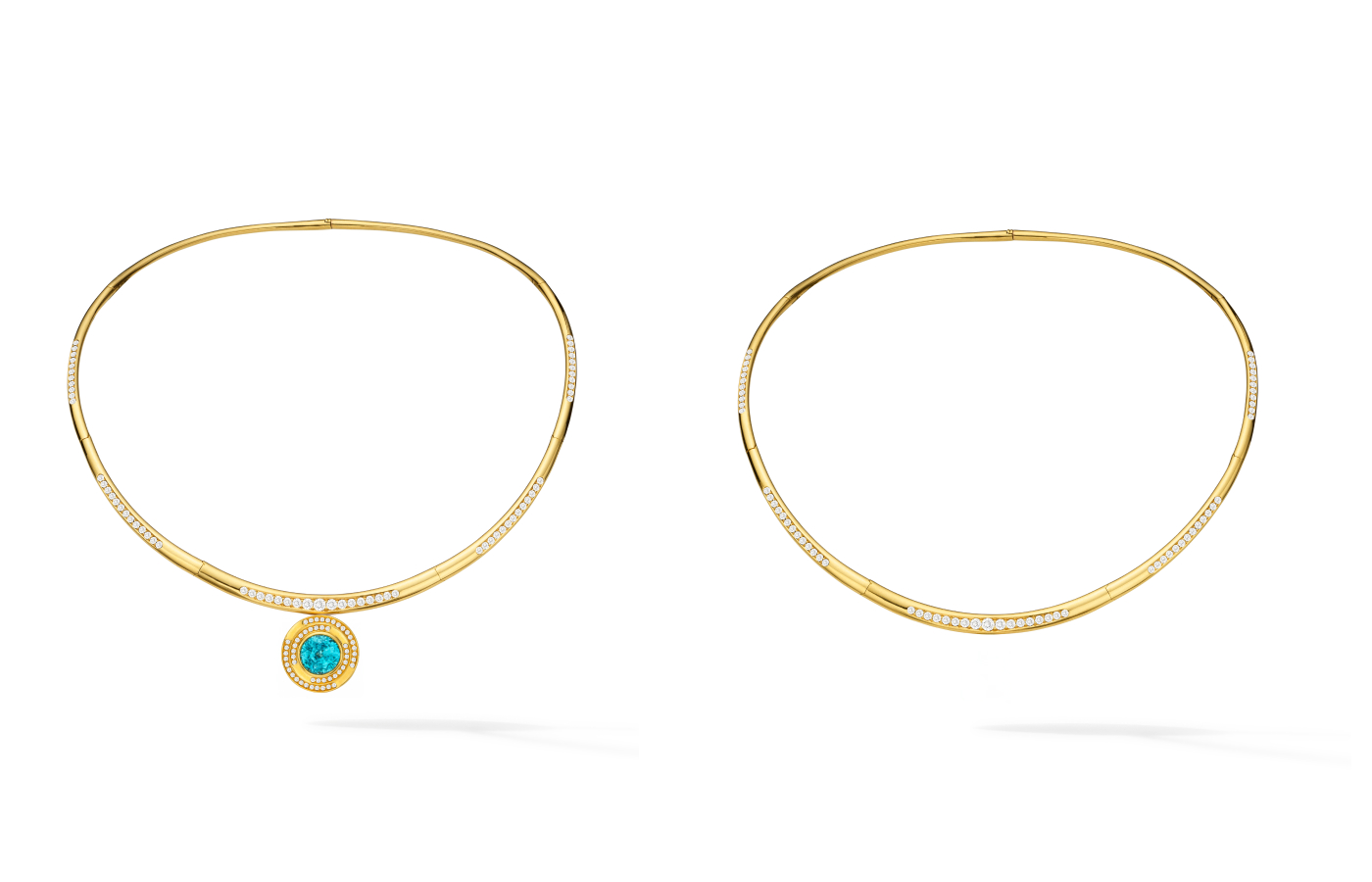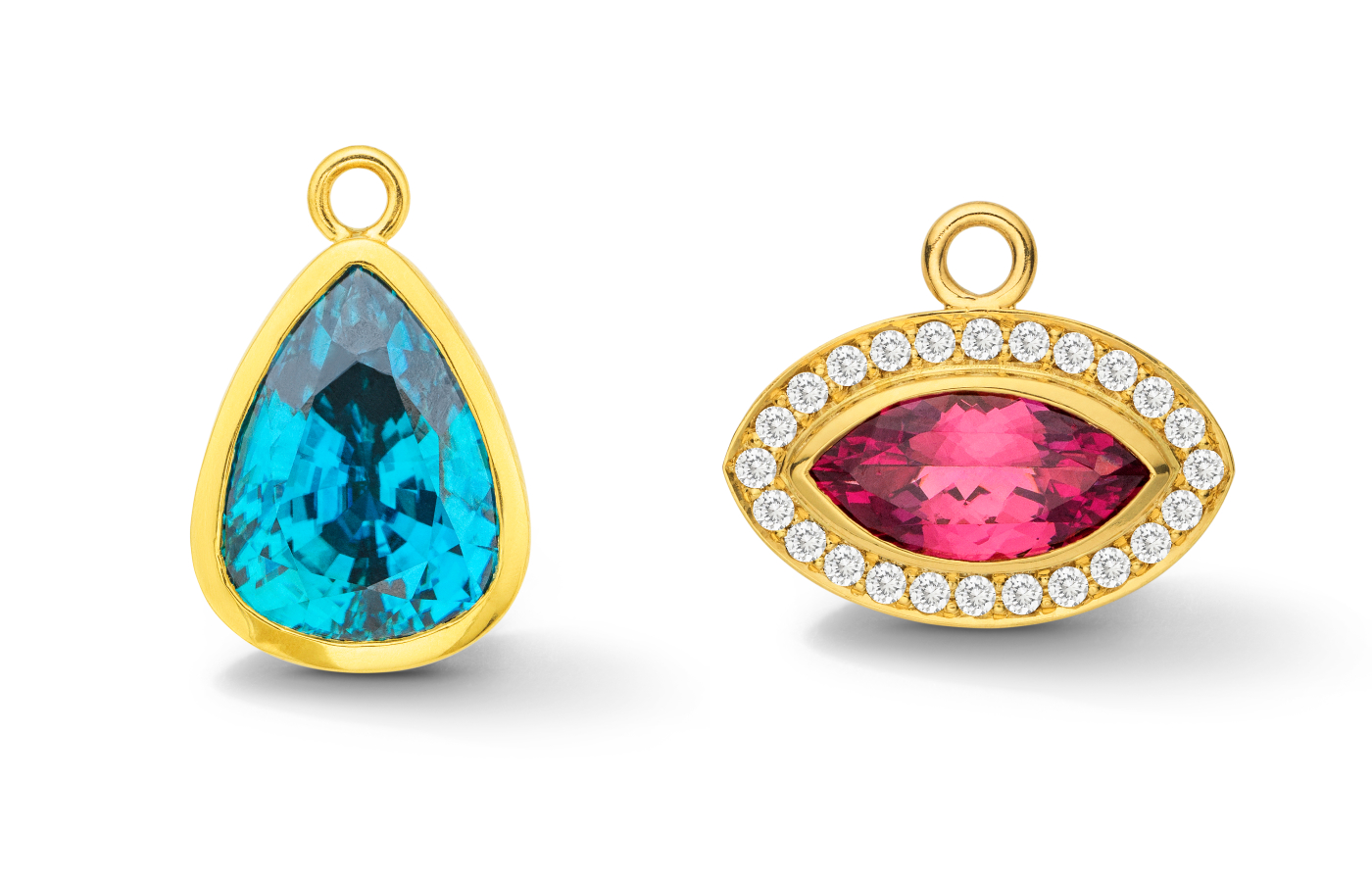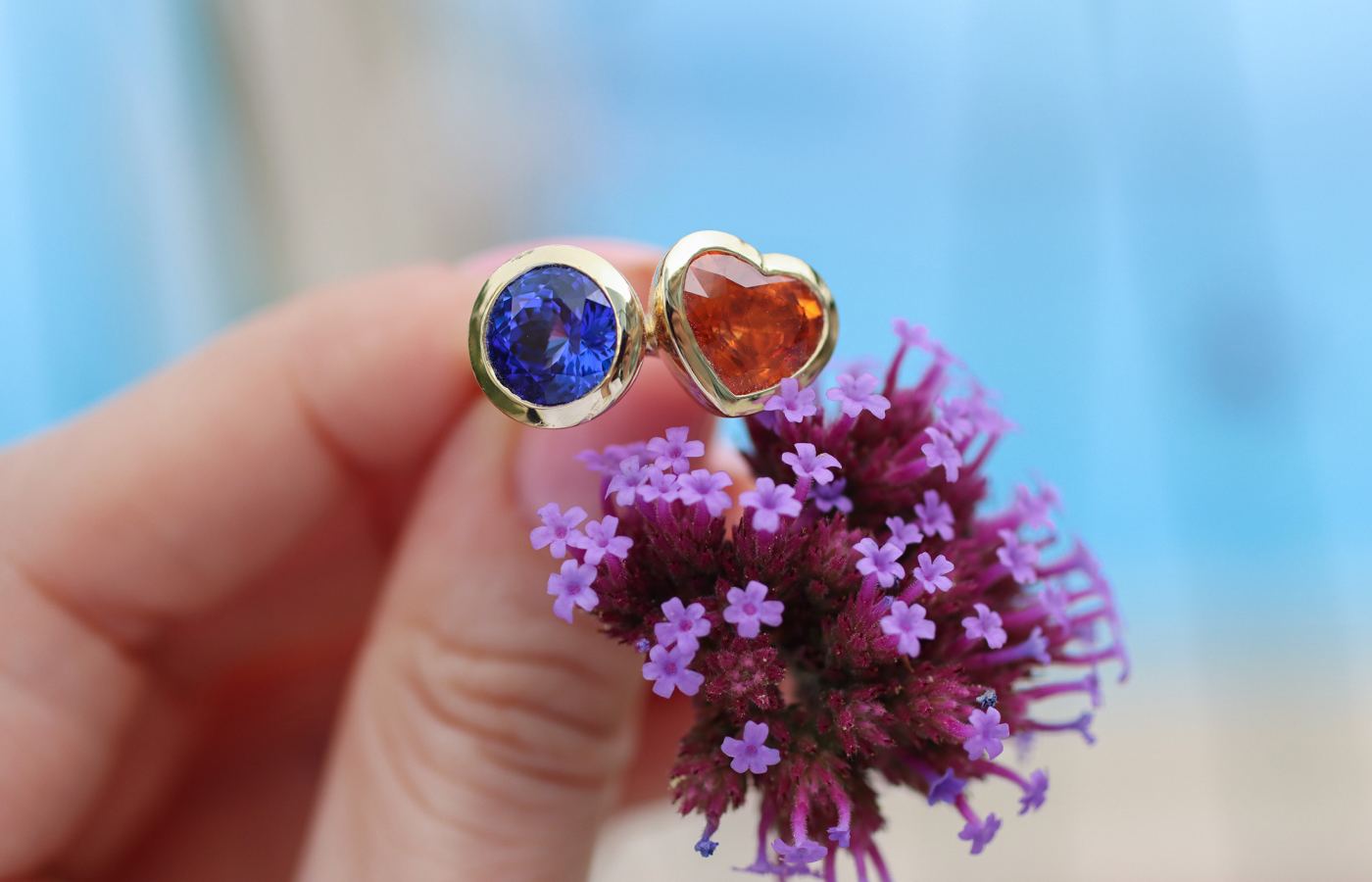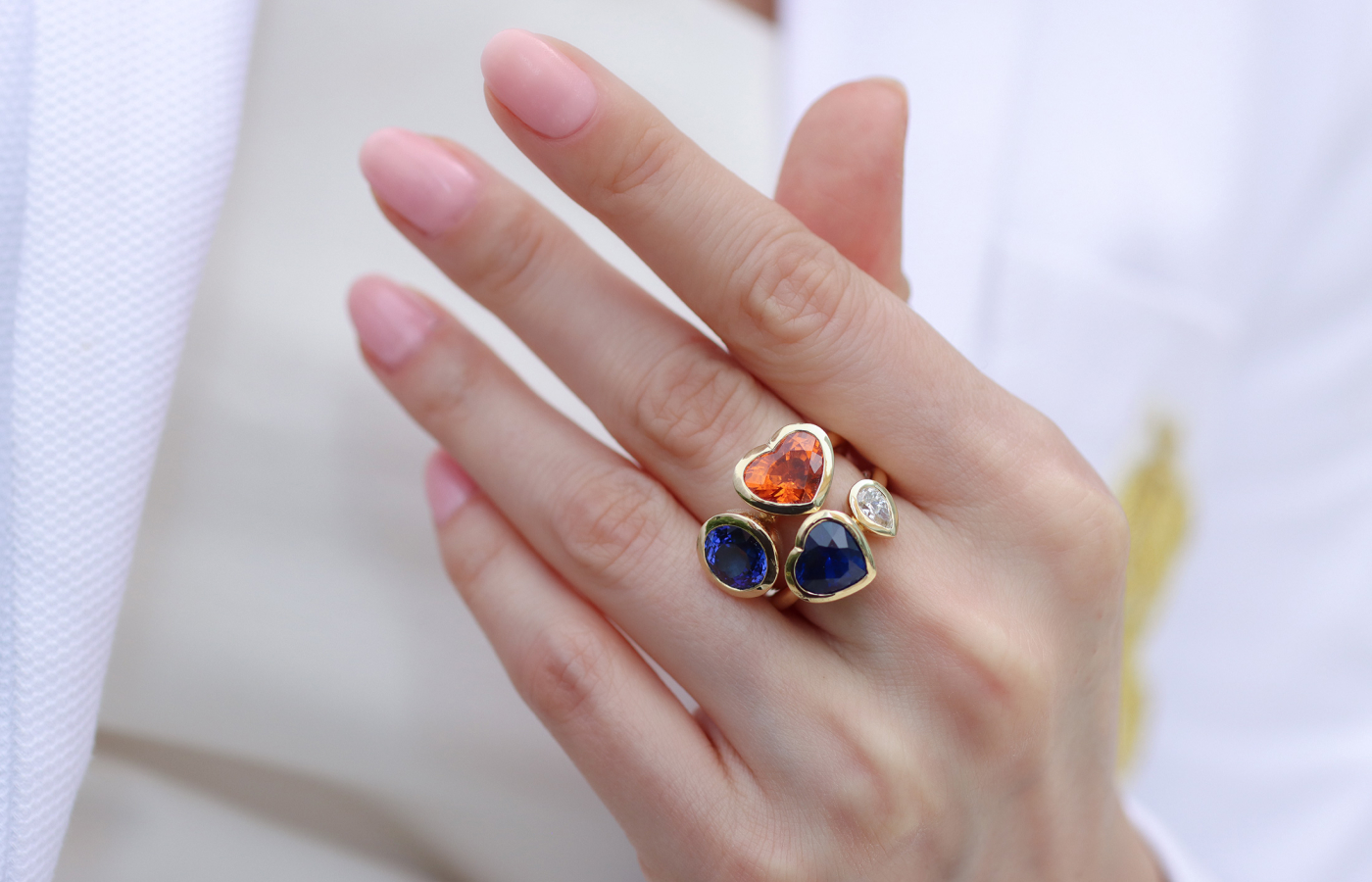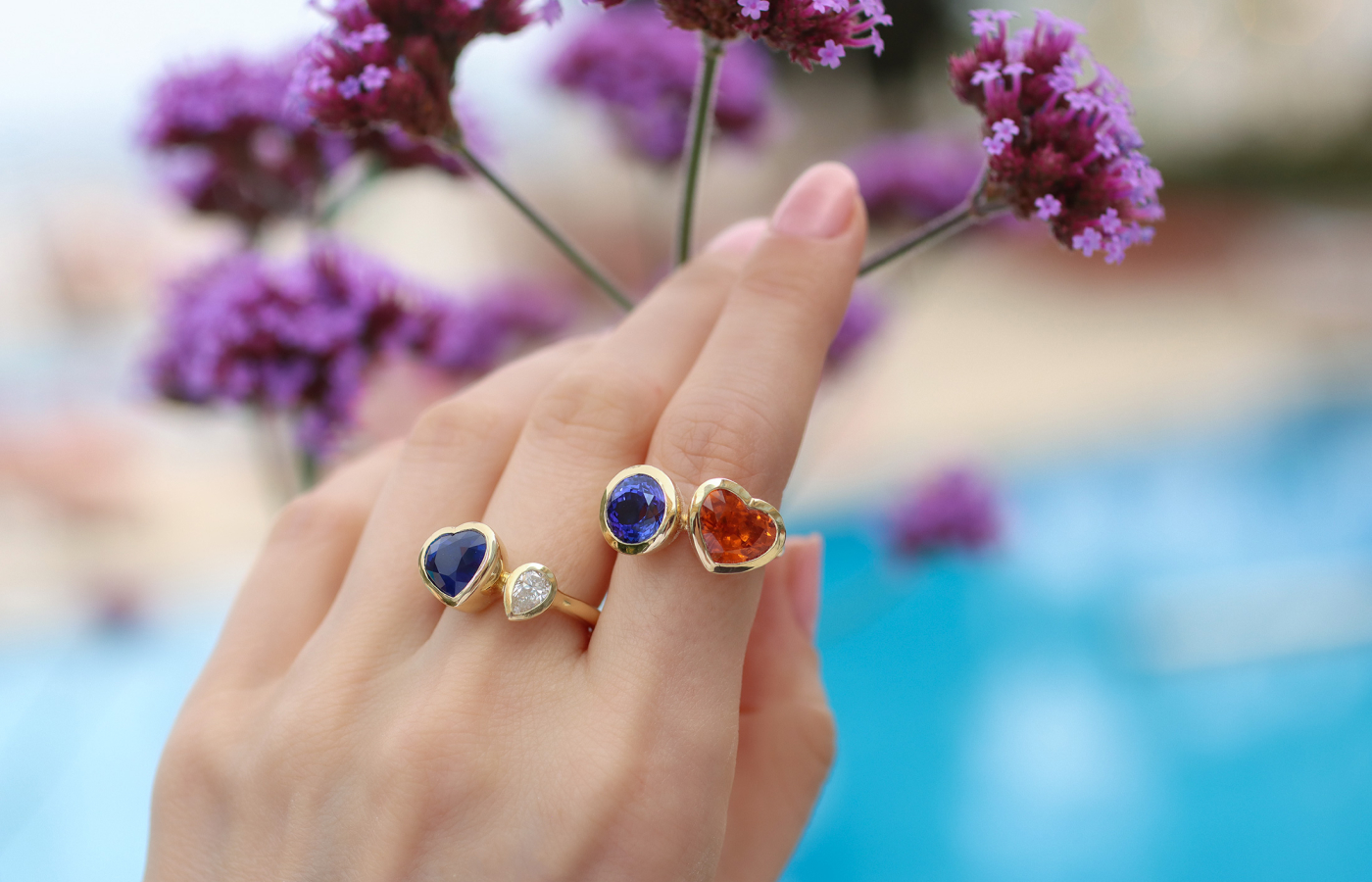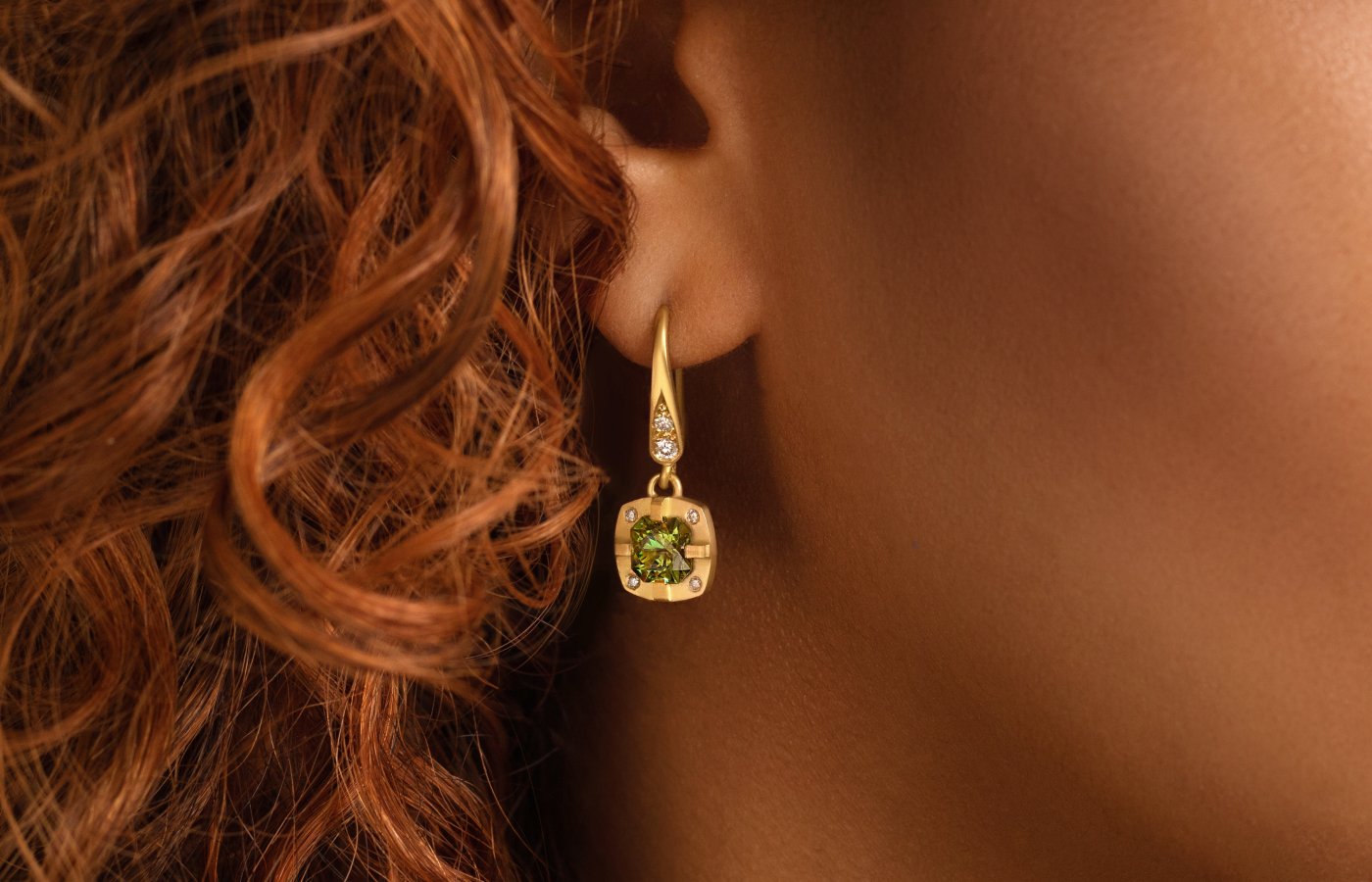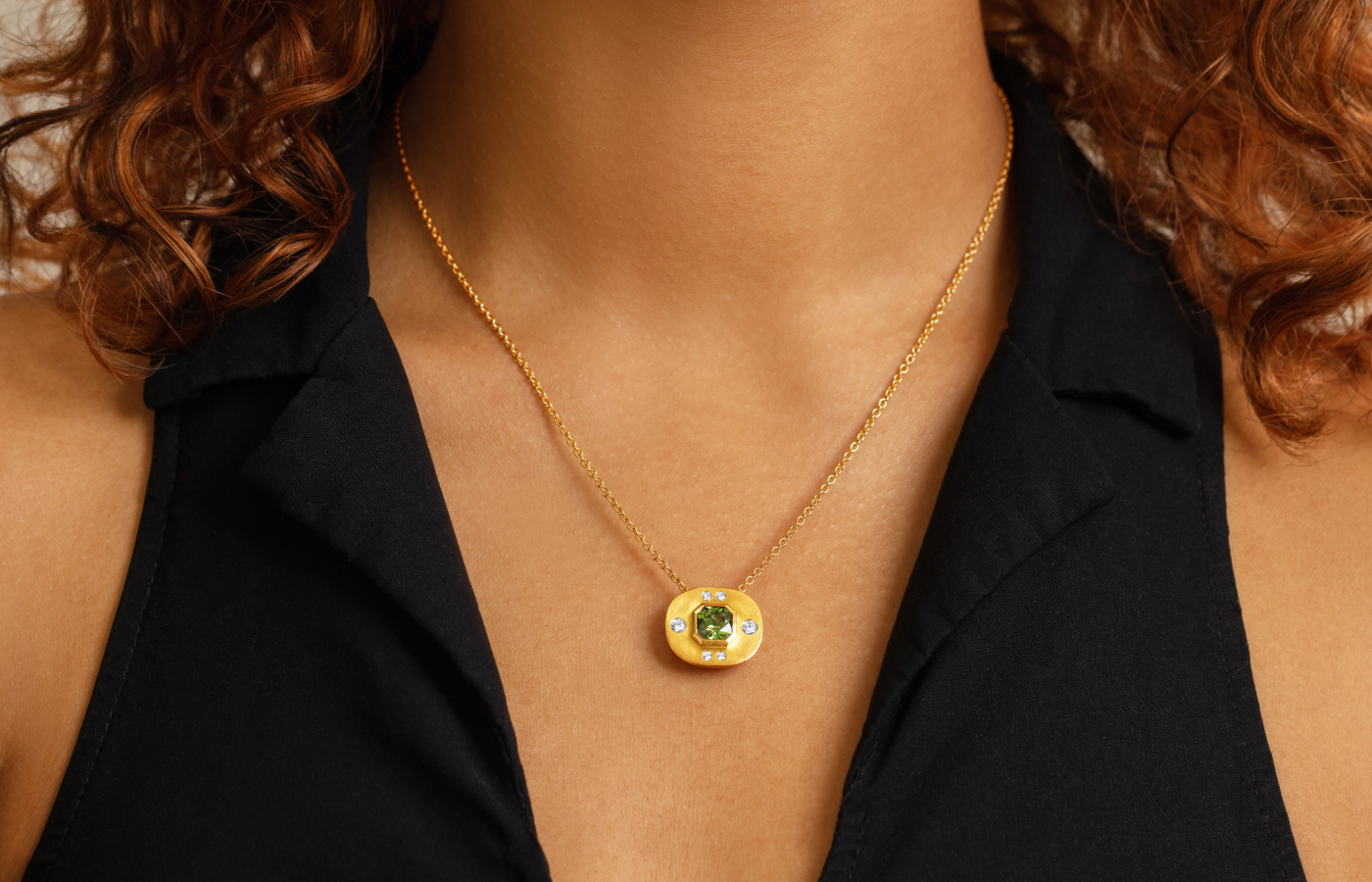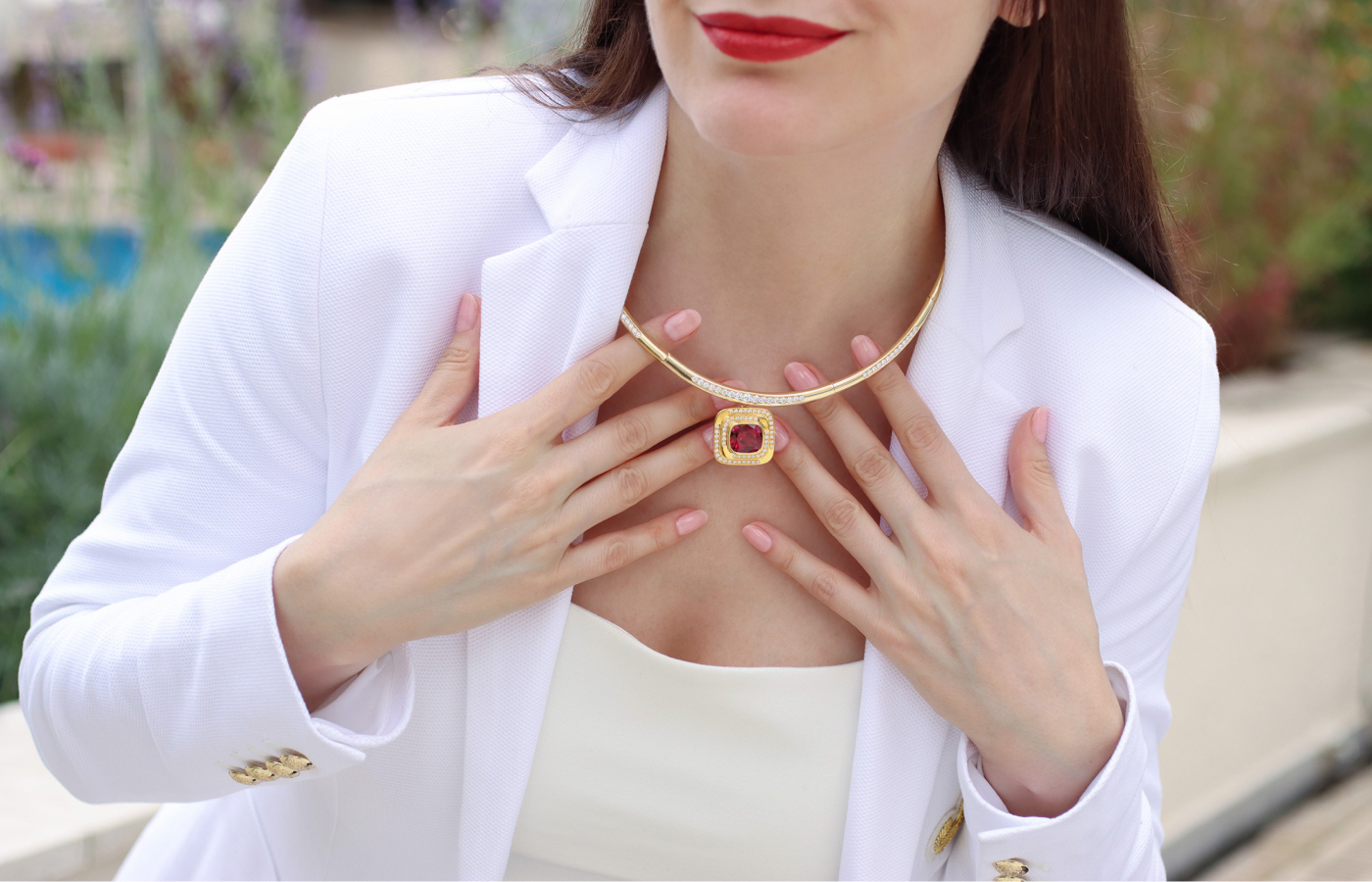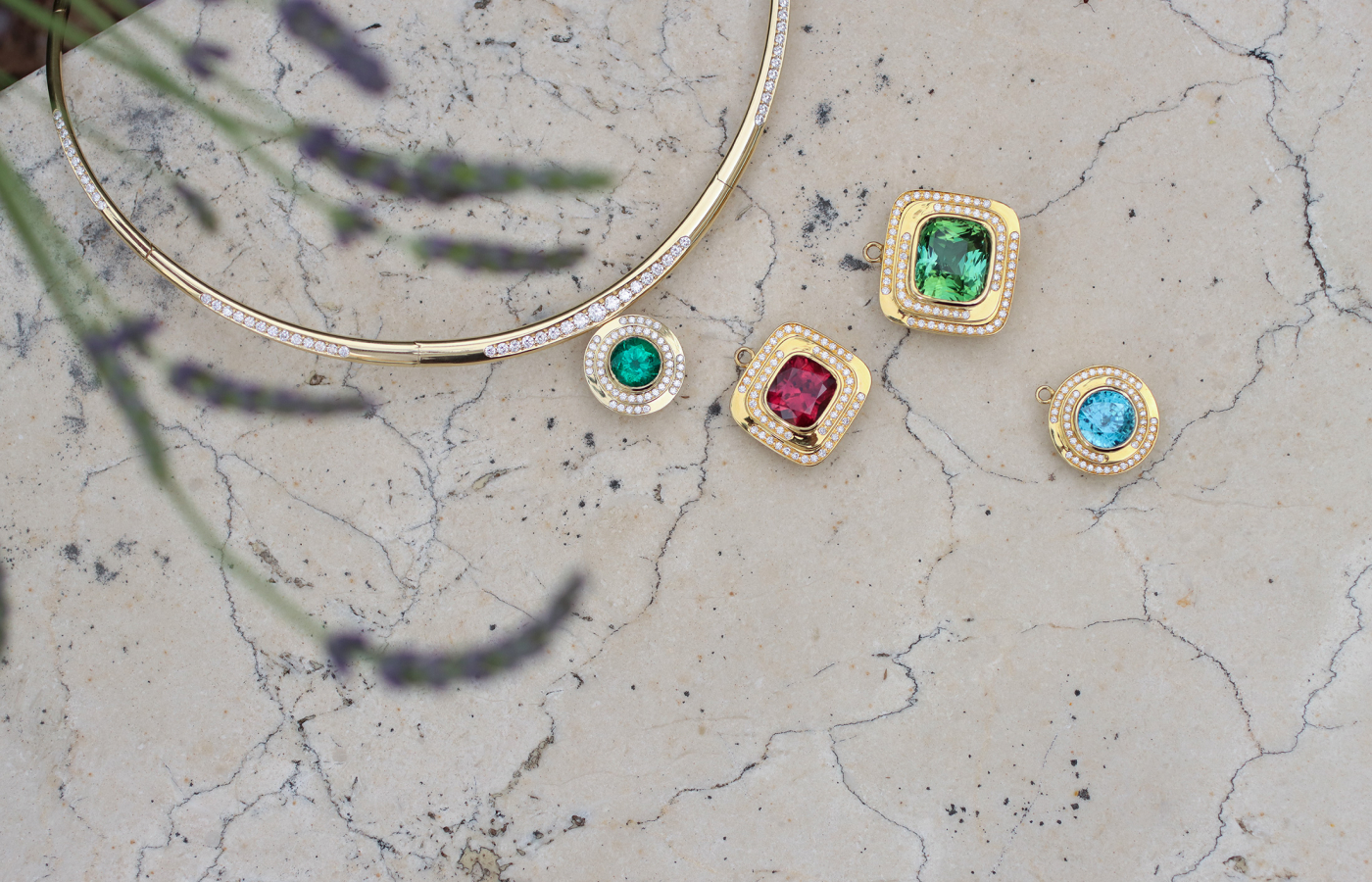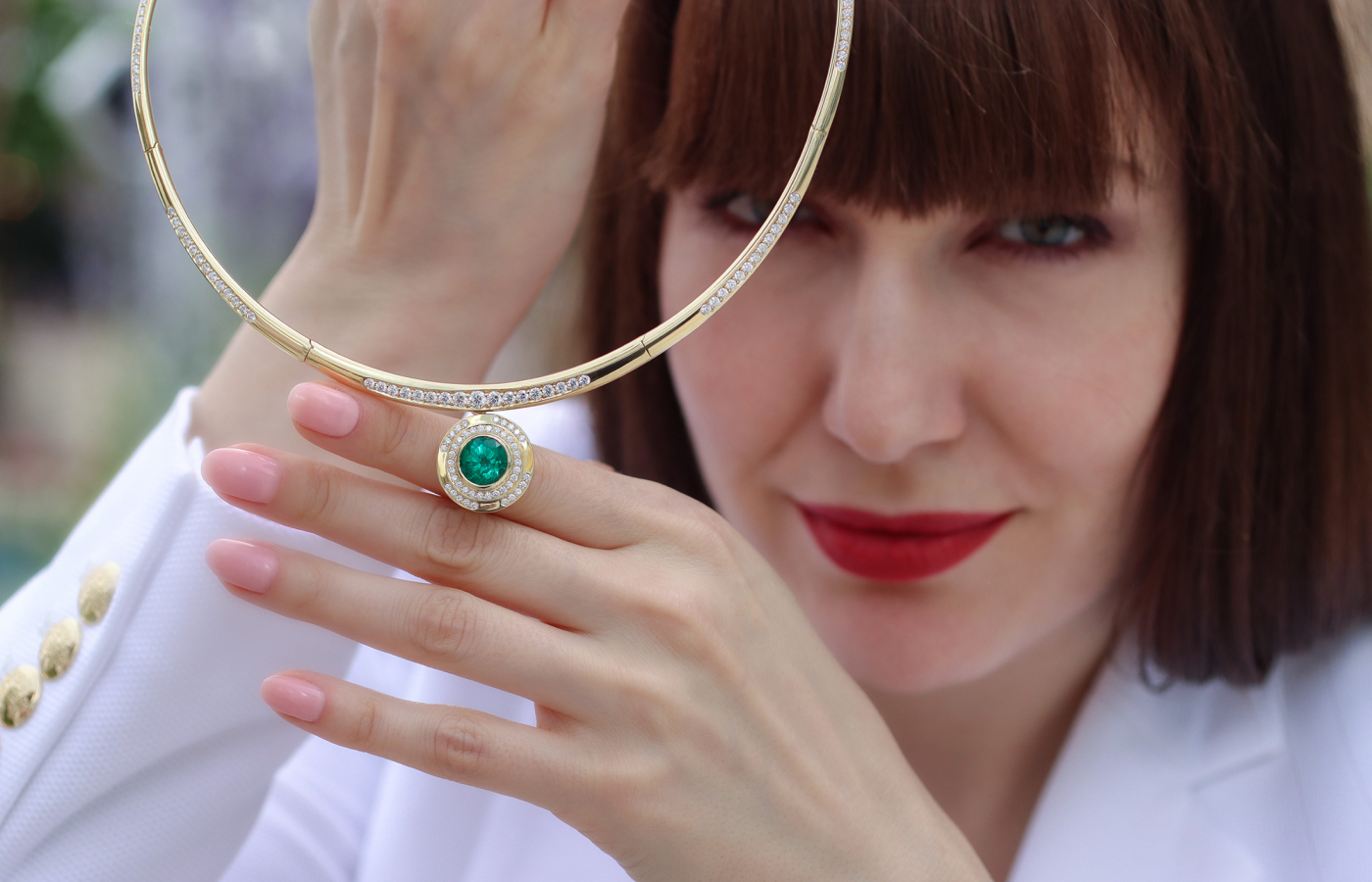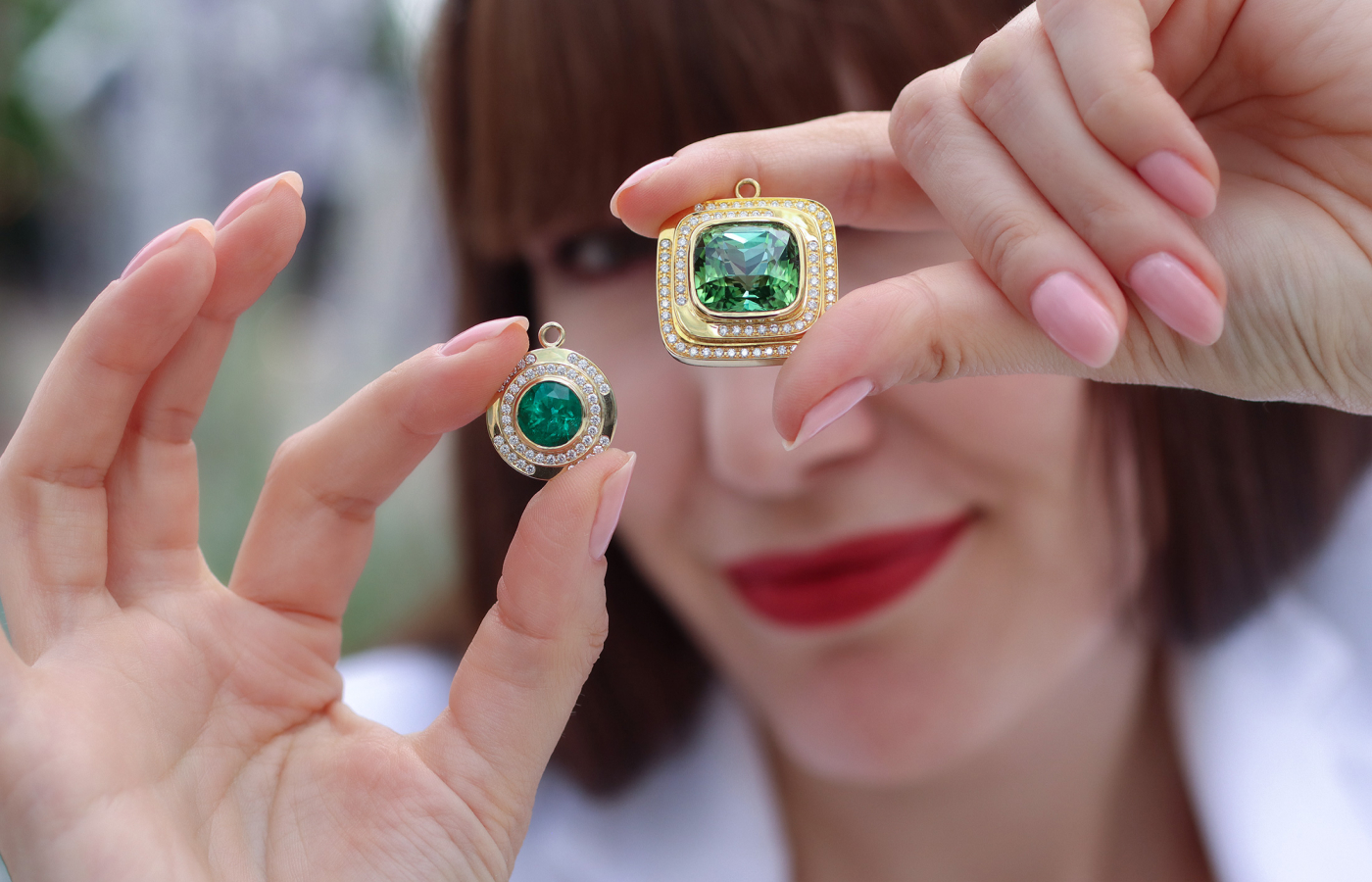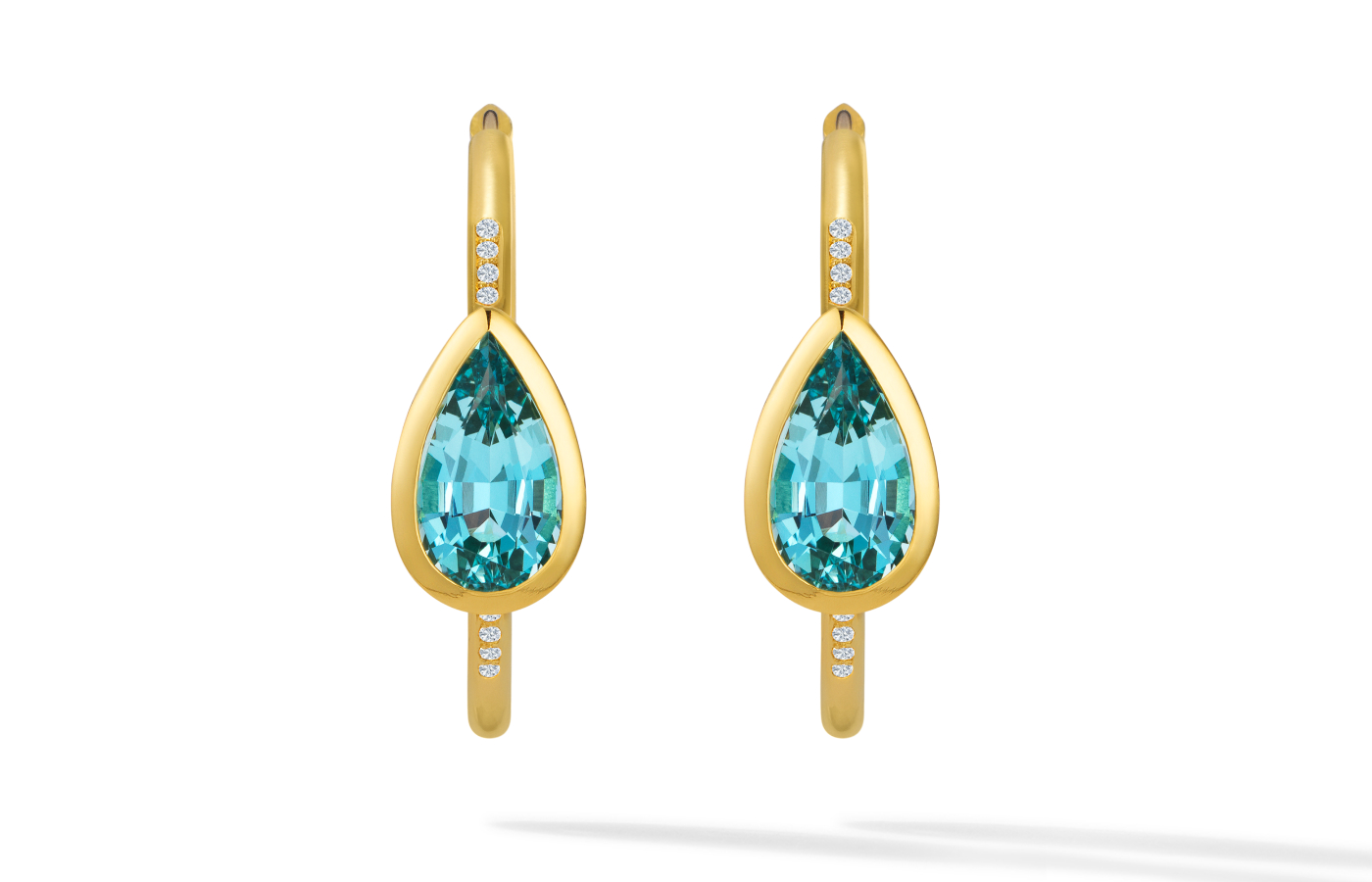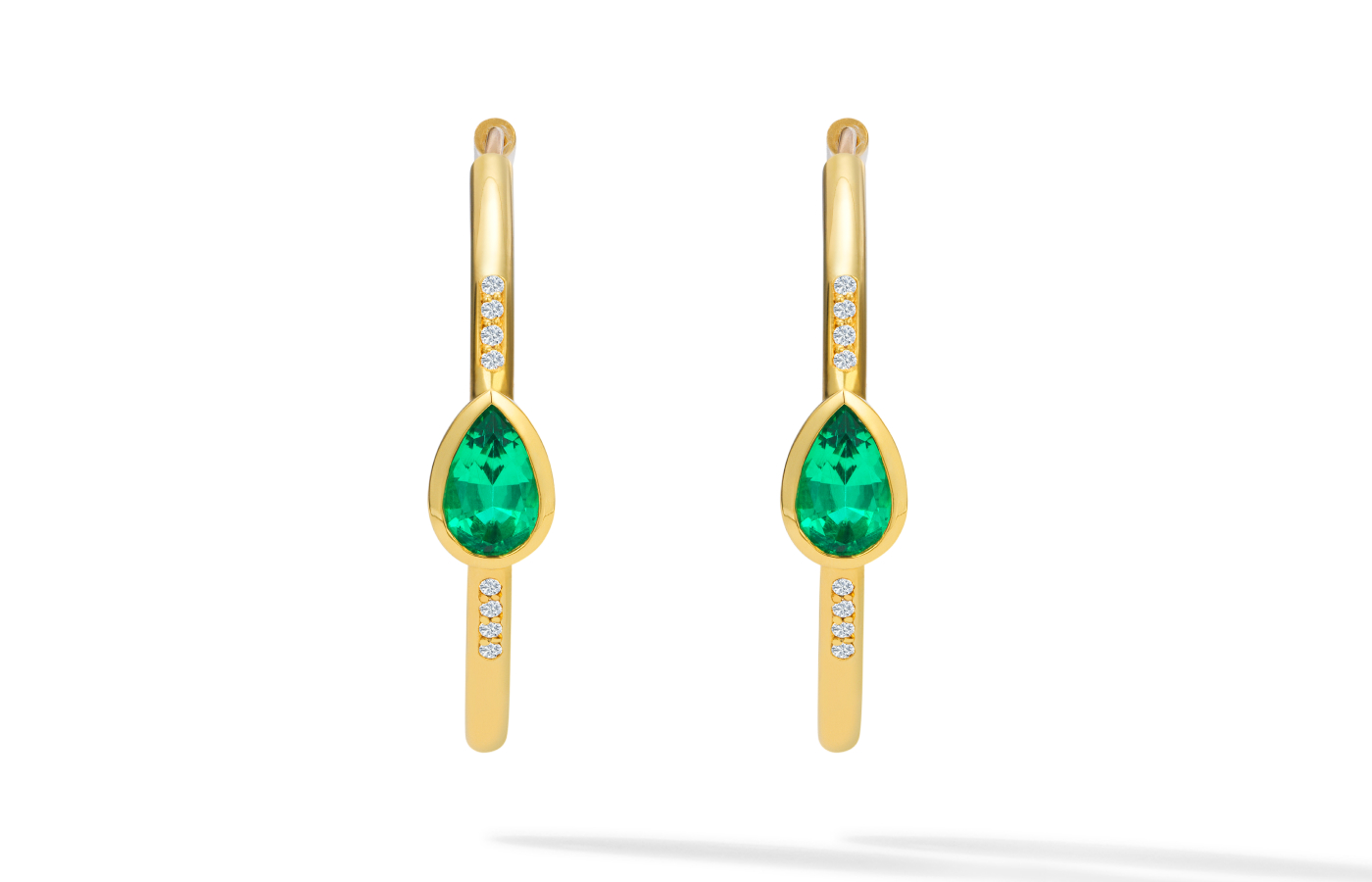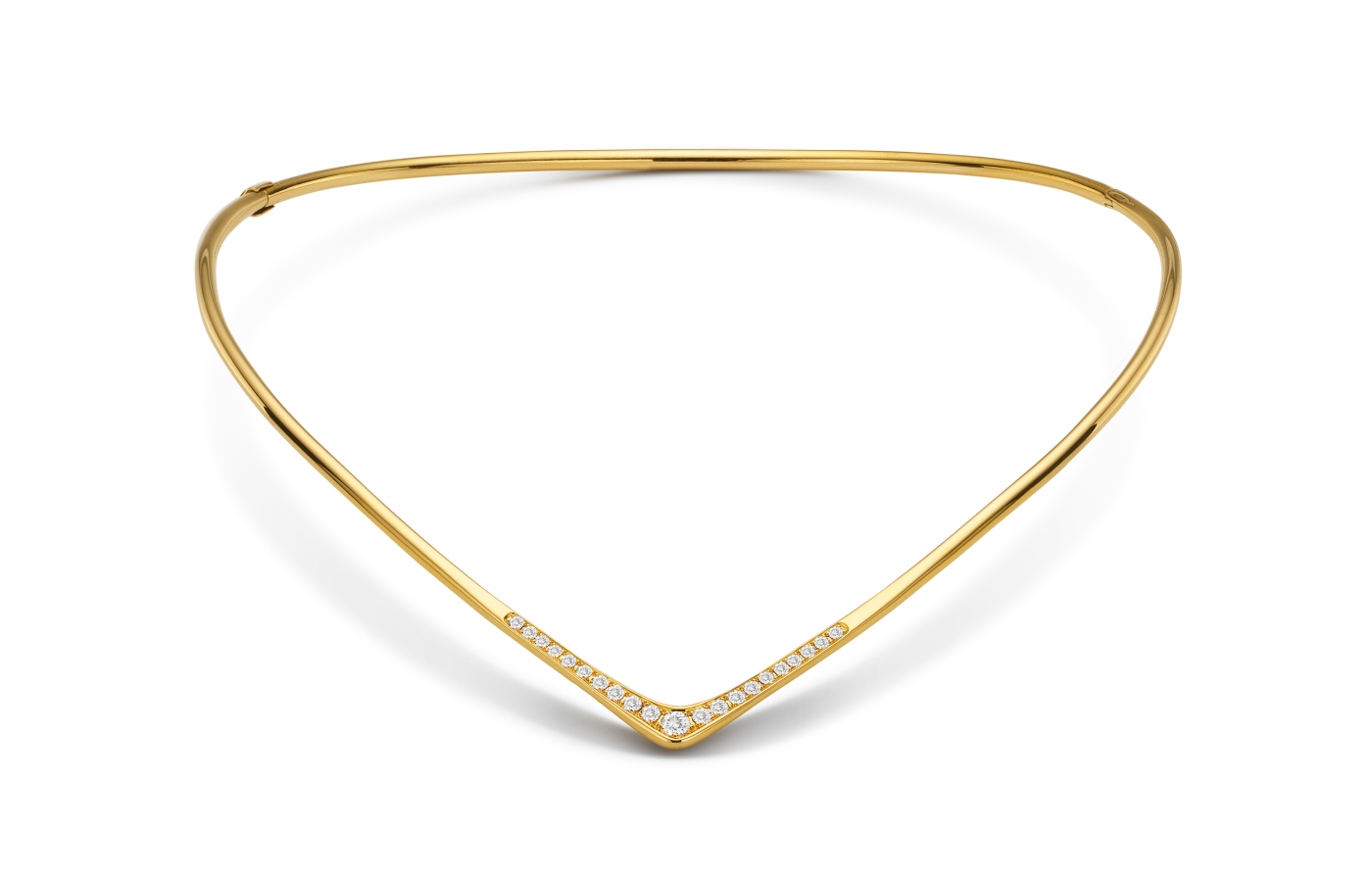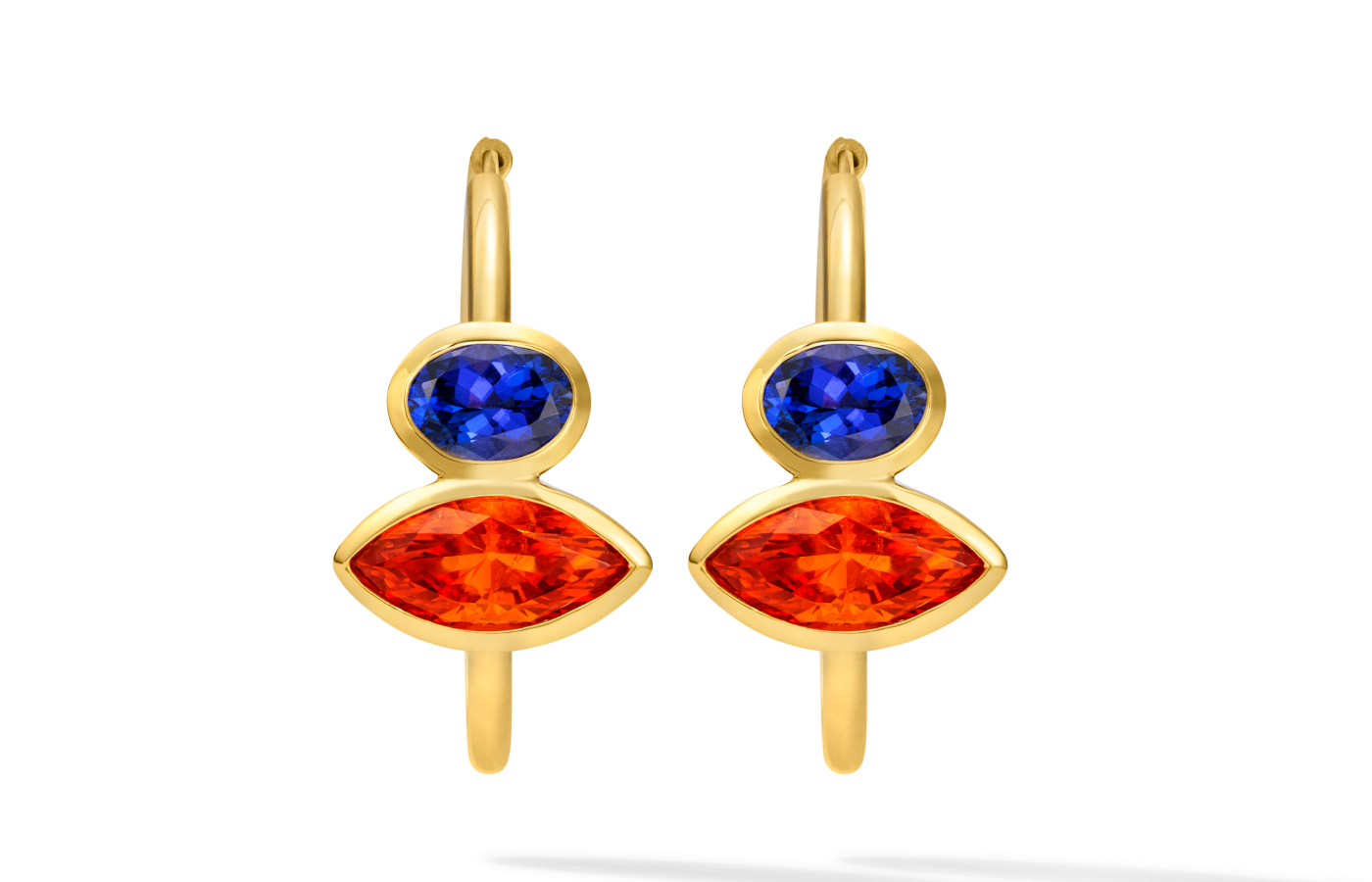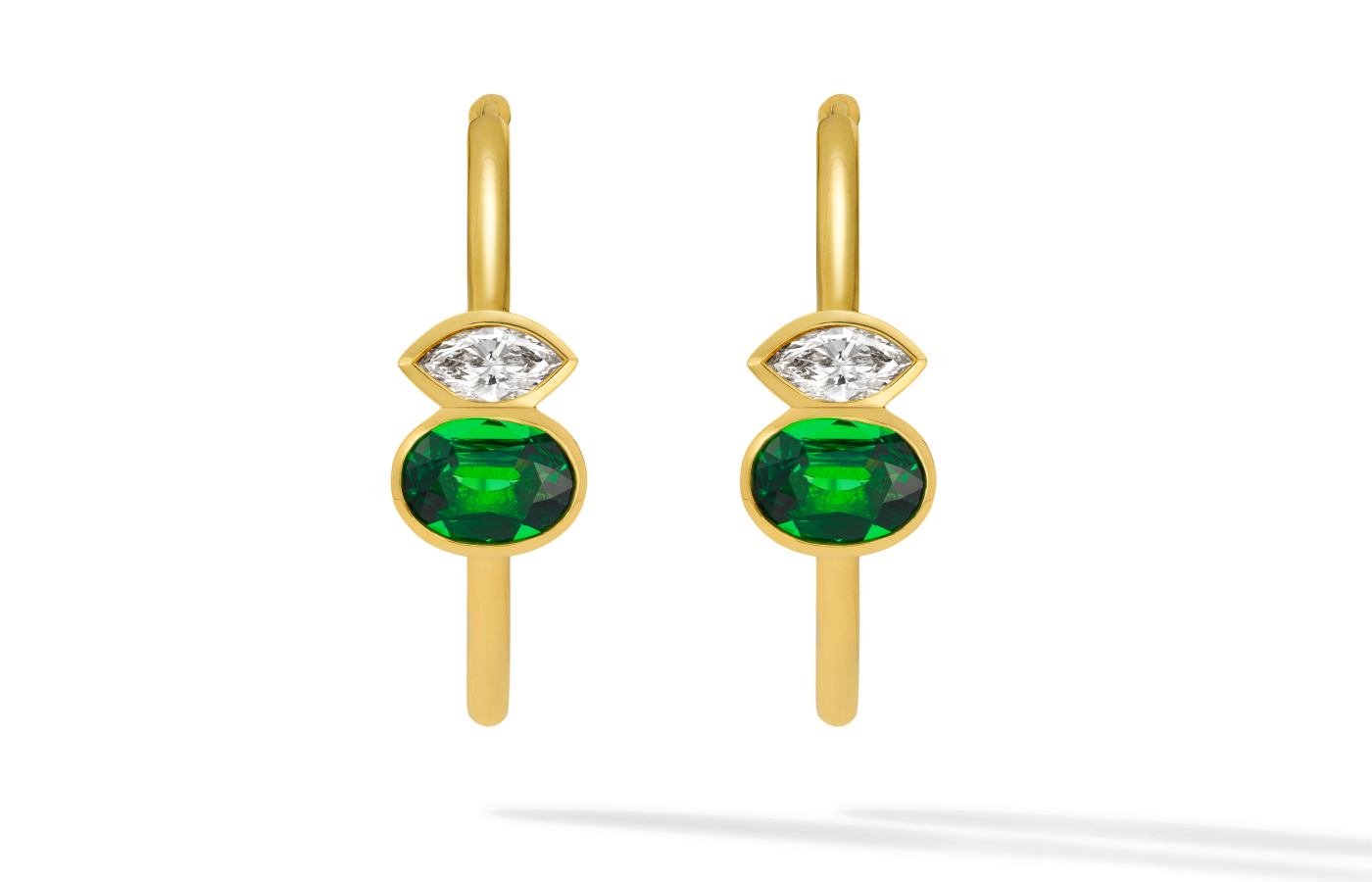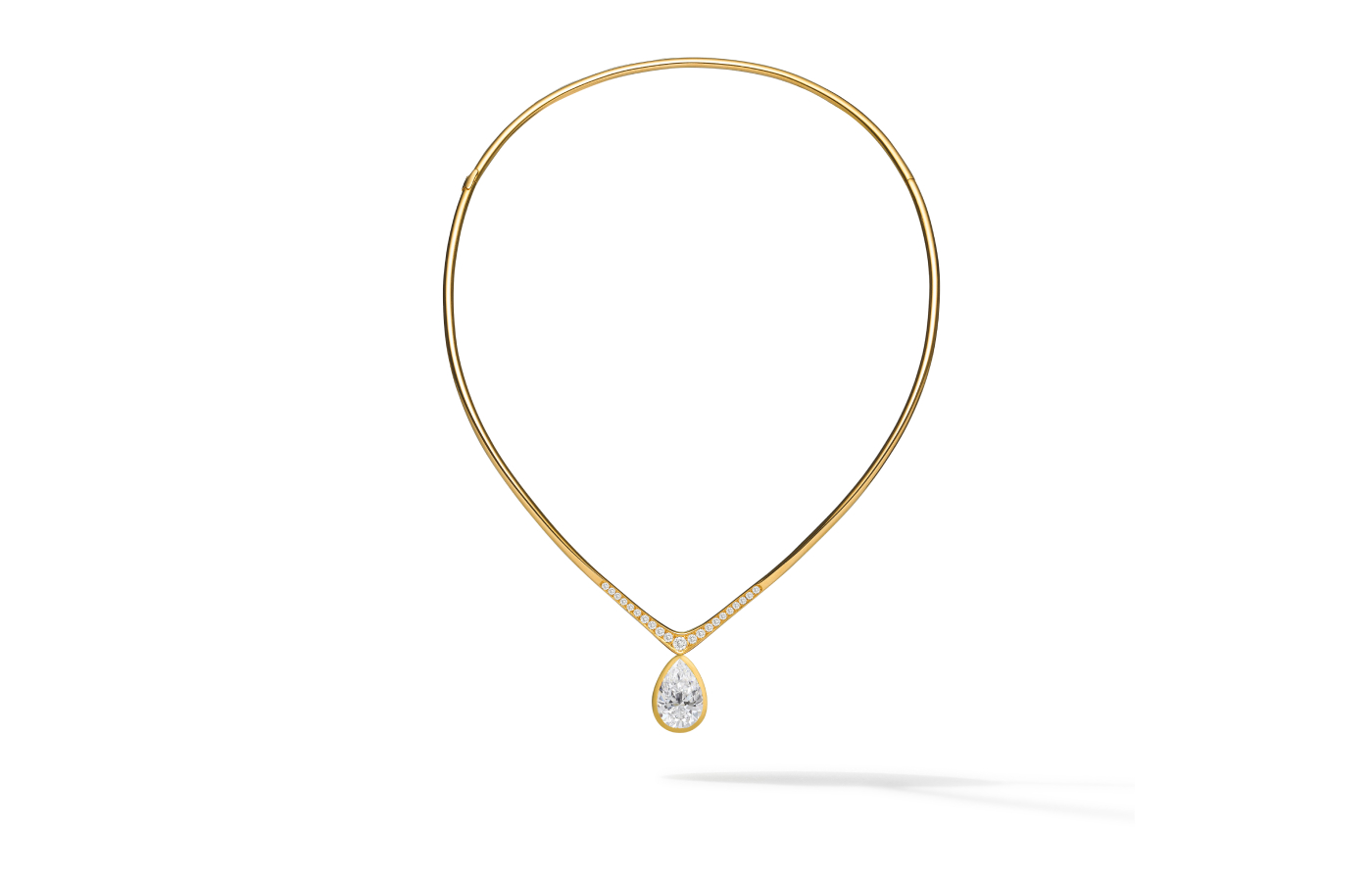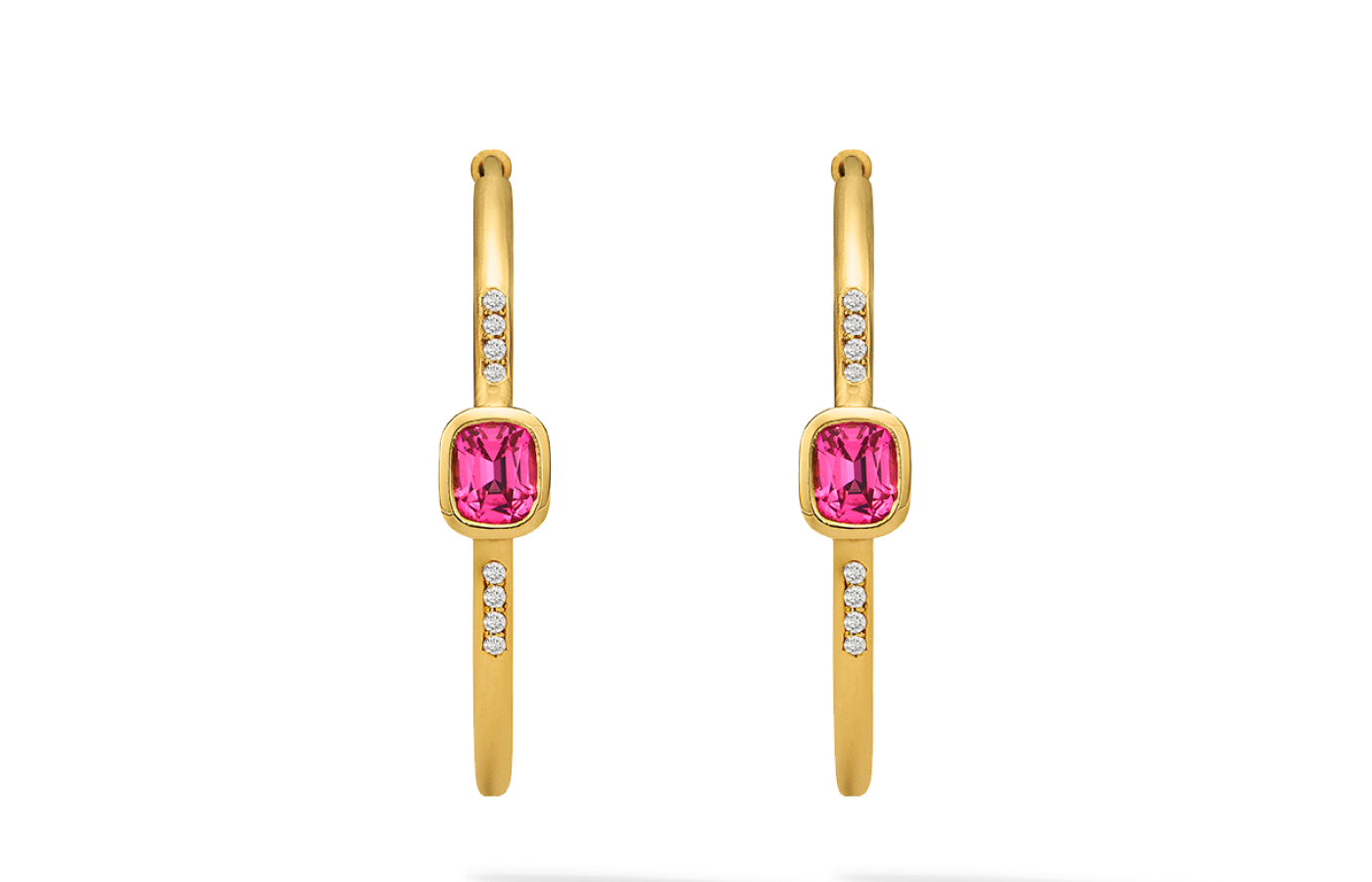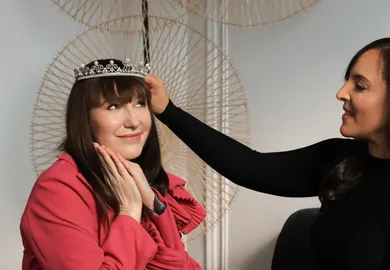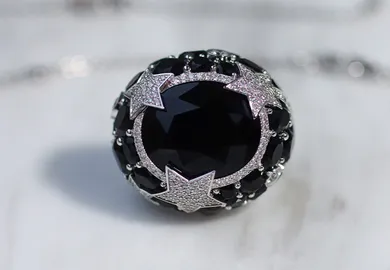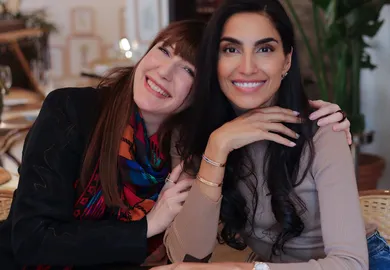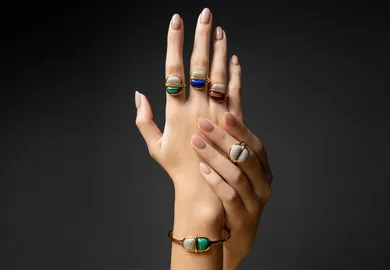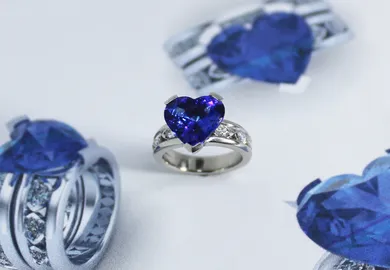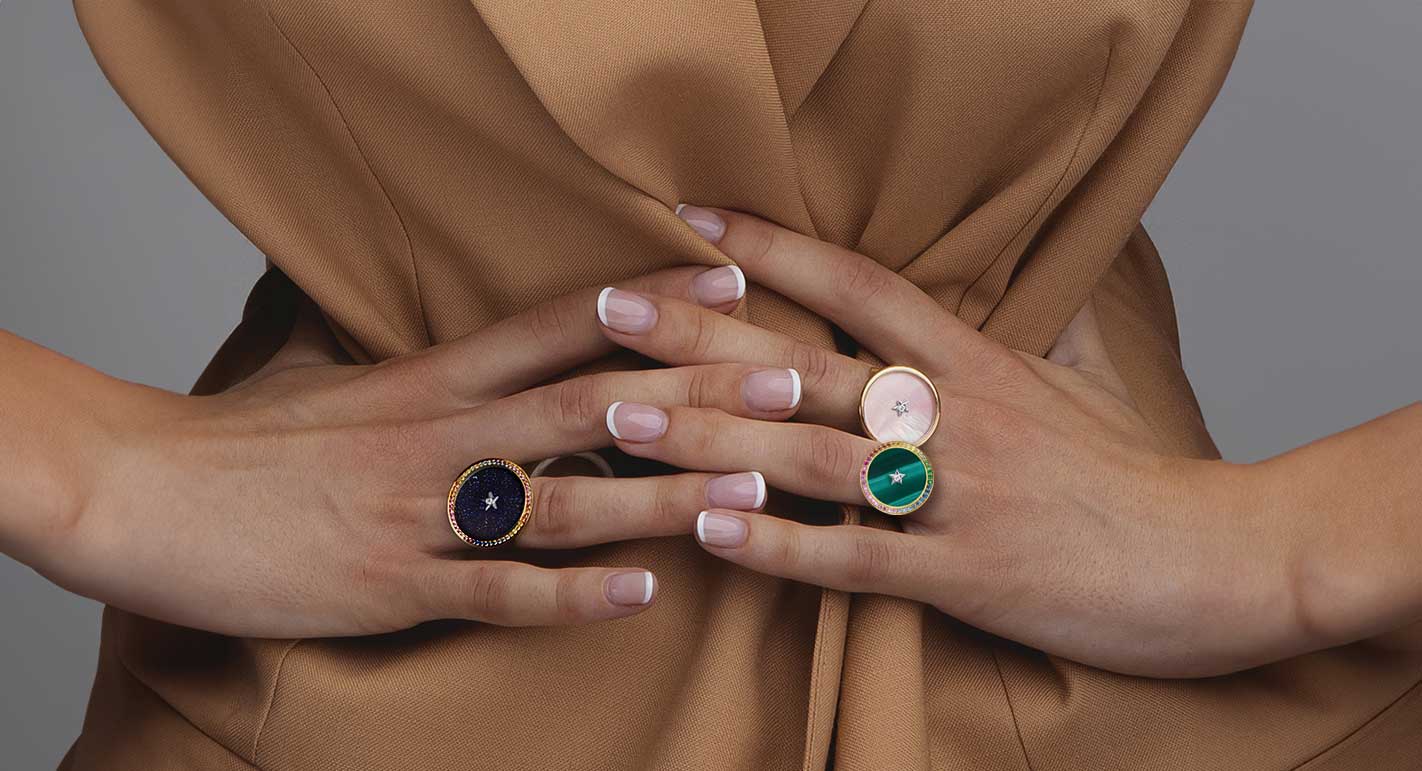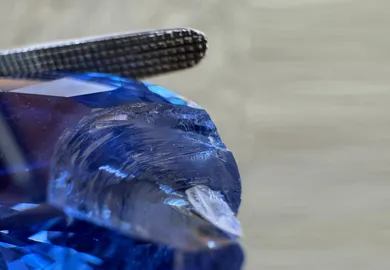
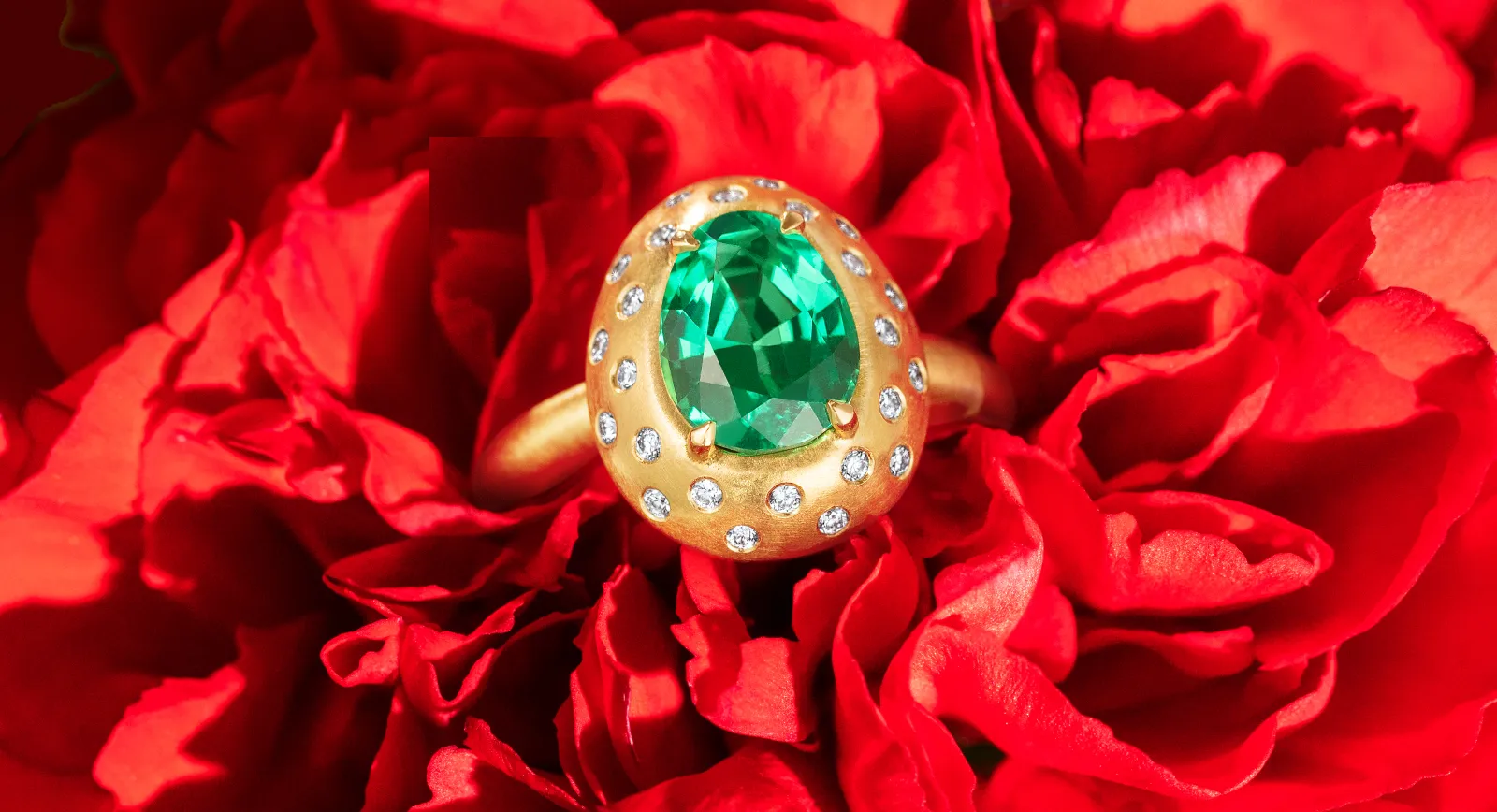
Exotic Appeal: A Passion for Rare Gemstones at British Brand Florence Carr
Recently, I had the pleasure of speaking with Florence Carr, who shares my absolute passion for coloured gemstones; the rarer and more exotic, the better! Her self-titled brand, previously known as Flosé, seeks to capture the attention of true individuals who value history, storytelling, art and the culture of gemstones through timeless works of wearable art. I was particularly inspired by a phrase on her website – “Become a flamingo among the flocks of pigeons” – which is a playful way of saying, go on, stand out from the crowd. If you’re looking to make braver and bolder choices with your jewels, consider the confident works of Florence Carr, pictured below, alongside the highlights of our conversation…
Intense, saturated, fiery, deep, bold, vibrant… these are all words we associate with the most brilliantly colourful gemstones. Someone who taps into these characteristics to great effect is Florence Carr, who works alongside her mother to source stones and design timeless, sleek and stylish jewels in London. Through colour, whether that’s mysterious grey, juicy orange or forest green, the brand’s jewellery serves as a transmitter for confidence, allowing the wearer to tap into their “own personal power”. I will admit, it’s hard not to feel energised by fizzing combinations of peridot and blue sapphire, violet-blue spinels and lagoon blue tourmalines, especially when they are set in pieces that can comfortably be worn daily, all year round.
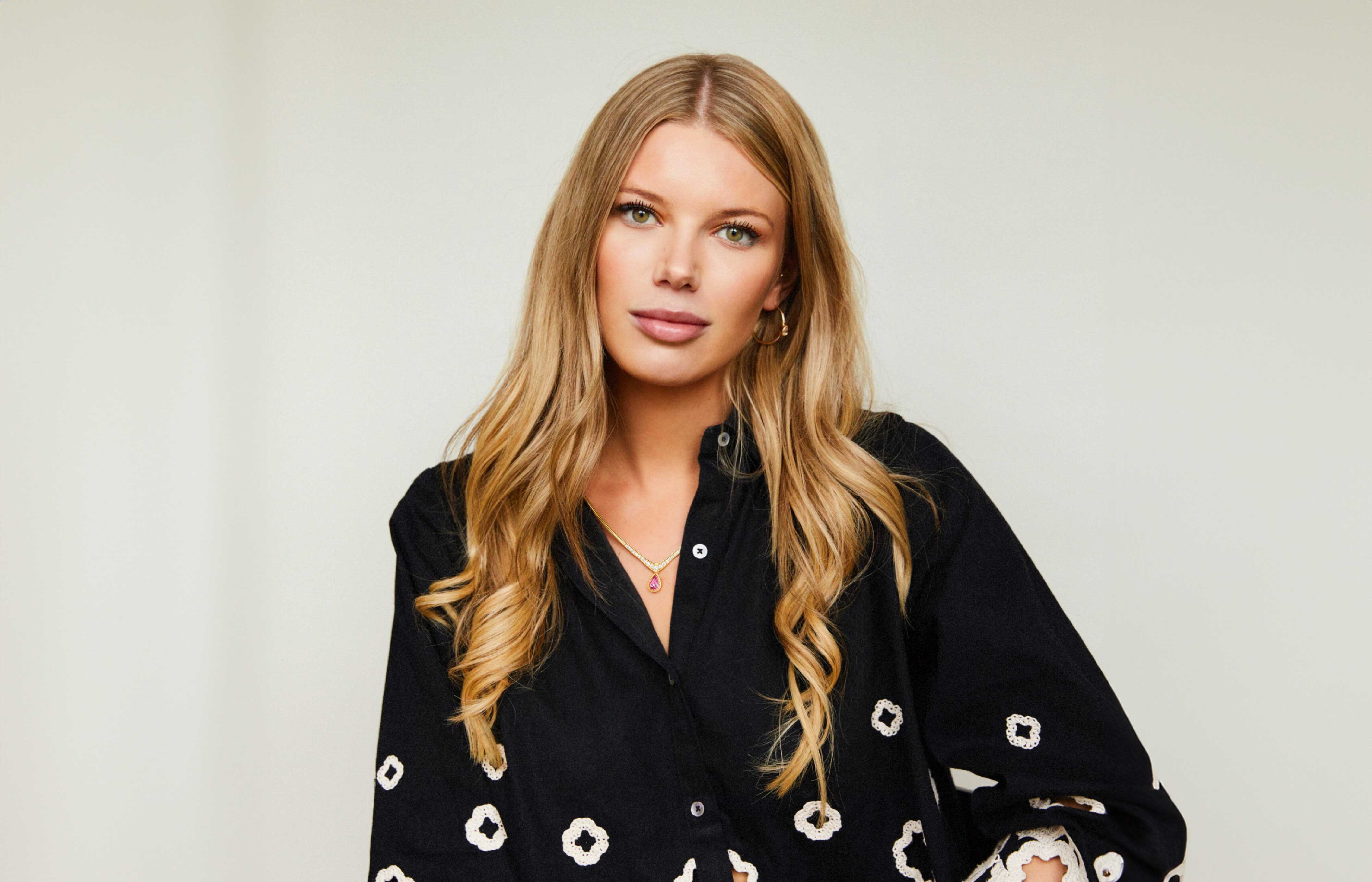
Jewellery designer and gem lover, Florence Carr
We truly believe that beautiful stones speak for themselves… they don’t need dressing up to show that they’re beautiful. We also believe that jewellery is only expensive if it sits in the dresser. We want people to be able to wear our jewellery every day. – Florence Carr
Before I present some of the best bits from my conversation with Florence, I’d like to take a second to dive into the brand’s high jewellery, which centres on a series of necklaces with interchangeable pendants. There are striking bezel-set pear-shaped pink spinel and diamond drops, each weighing over three carats, and a series of Maze pendant styles featuring a 9.78-carat rubellite and a whopping 24.47-carat blue-green tourmaline. I appreciate the unfussy way in which these creations allow the central gemstone to have its moment in the spotlight… much like the aforementioned flamingo! More insights can be found below.
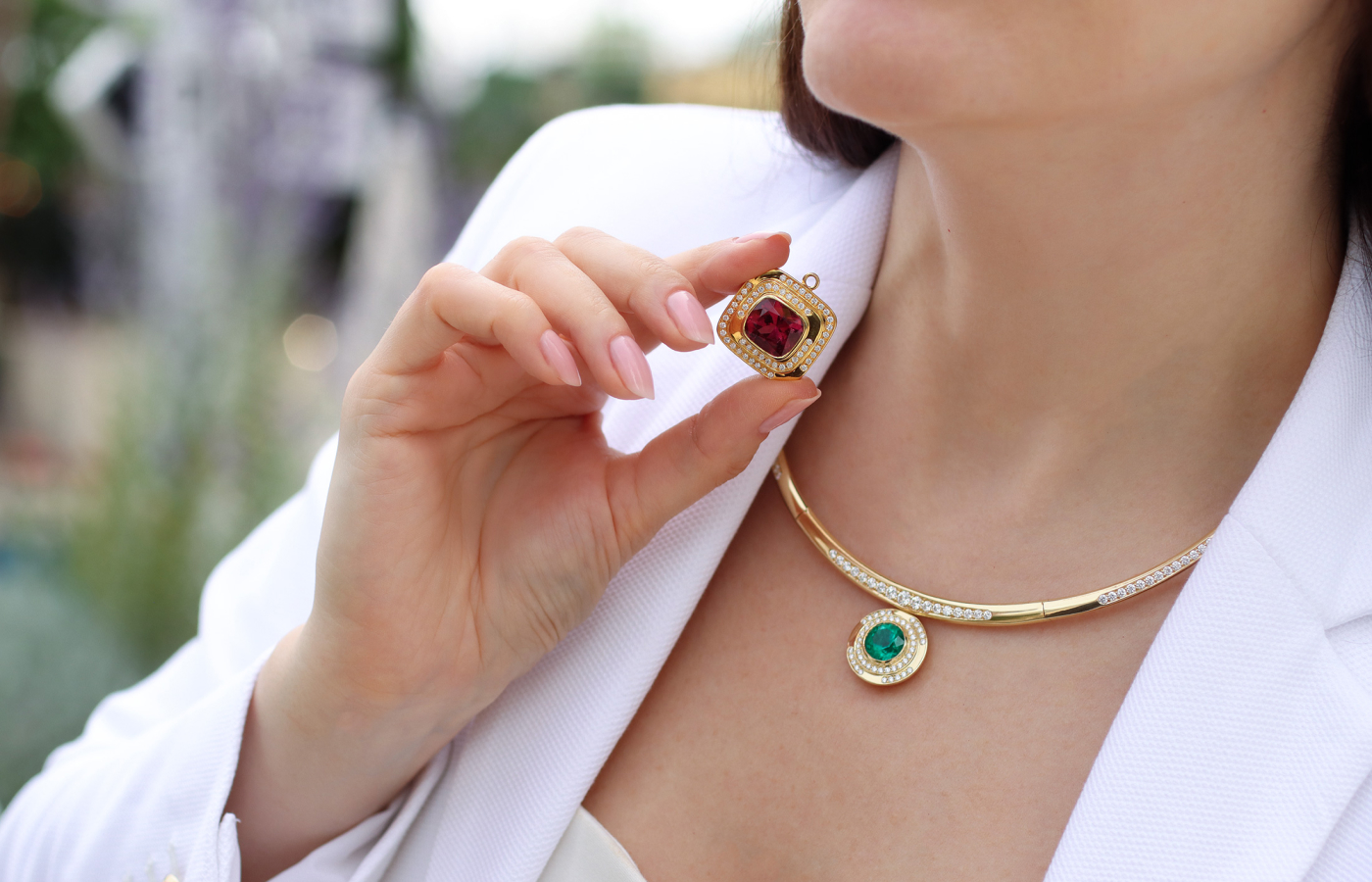
Katerina Perez wears the Florence Carr semi-flexible hinged torque necklace with 3.03 carats of diamonds and the detachable Maze pendant with a 4.2 carat emerald and diamond pavé, while holding the detachable Maze pendant with a 9.78 carat rubellite, all in 18k yellow gold
Katerina Perez: Florence Carr is a family affair and I know your Mum is involved too! How do you go about creating jewellery together?
Florence Carr: Our jewellery-making process starts with a stone, either sourced or given. In-house, we design it and send it to a team in the Goldsmith’s Centre in London, who really do transform these gems into the timeless pieces of art they are. My mother is the gemmologist, and we source the gemstones together. It’s never hard, as we always spot or reach for the same stones! I am primarily the designer and, secondarily, an artist and marketer.
KP: Can you tell me more about your sourcing process? Do you travel to exhibitions or have trusted suppliers that you return to?
FC: My Mum is a gemmologist and has been collecting precious gemstones for decades now. Her love for precious colour gemstones started when she was a child in Nigeria collecting pebbles and stones as her father (and my grandfather) was a geologist for Shell. She has one of the best eyes in the game, and I’ve learned a lot from her. We go to Tucson every year and have all our favourite suppliers there, but now I often visit Bangkok to see them at other times of the year. My Mum has been on trips with Gem-A to Kenya and Tanzania to see the tsavorite garnet mines and buy from women miners in collaboration with ANZA Gems and Gem Legacy. She is also visiting the opal mines in Australia this year with a few other gemmologists.
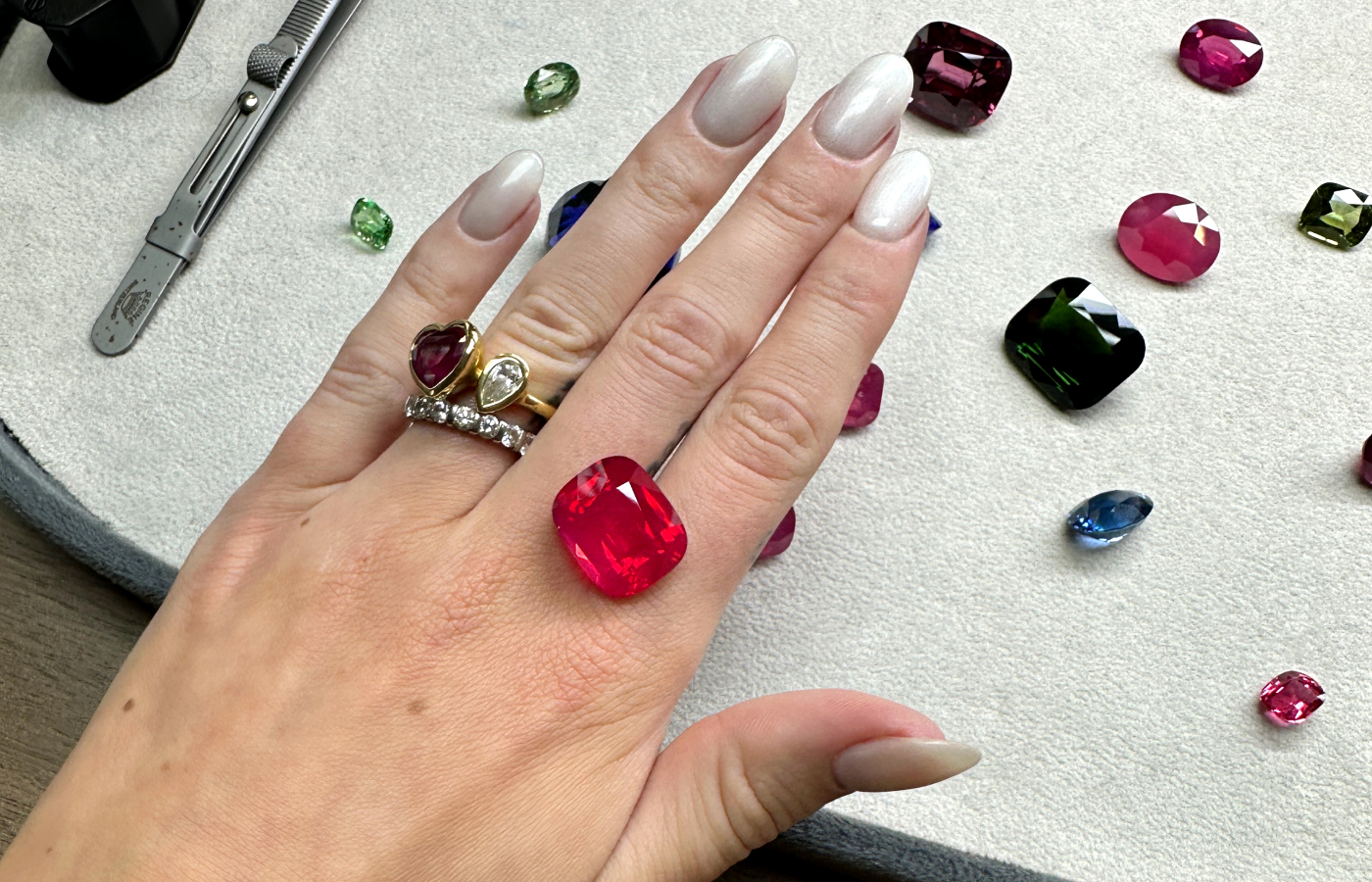
Florence Carr presents a once-in-a-lifetime Mahenge velvet red spinel of 21 carats, courtesy of Lambert Vissot (aka @iamgemhunter)
KP: Colours often carry deep meanings in jewellery. How do you select gemstones from such a wealth of minerals?
FC: Historically, the colours of gemstones have been used to help dictate their energetic meanings, such as ruby red being a symbol of love and passion. However, I tend to choose gemstone colours to evoke specific emotions based on where I see that gemstone and piece of jewellery being worn or connected to. For example, I envisage our bright, sparkly blue zircon cocktail ring being worn in a sunny beach environment by the water or on a yacht sparkling in the sun. Whereas something like our grey spinel drop earrings I see as being worn somewhere like the UK… they have colour and life to them, yet as a culture we have much more of an understated aesthetic (and weather to match!) so more muted colours suit the British taste and values more. Although I try to create colour combinations that would appeal to anybody, no matter their race, ethnicity or origin, I love to visualise the sort of person wearing my jewellery.

Katerina Perez wears a Florence Carr cocktail ring with an 11.92 carat blue zircon and diamonds accents, set in 18k yellow gold
KP: How do you incorporate spirituality, myths, legends and the raw energy of precious stones into your designs?
FC: I studied Religion, Politics and Ancient History at the University in Cape Town, and I have always had a longstanding fascination with how everything is connected, underpinned by universal energies and religions, whether you believe in spirituality or follow a religion yourself. The same shapes and symbols underpin our lives on a daily basis and have existed and been worshipped in diverse myths from civilisations all thousands of miles apart, so I really wanted to reflect and honour these beacons of power in our jewellery. For example, in our ‘Ortus’ collection, which we started when the UK started to emerge from post-pandemic life, we wanted to use the universal symbol of the ‘egg’, which has been used to celebrate renewal and rebirth of life into a new reality throughout history. So, we used egg-shaped stones to create the collection.
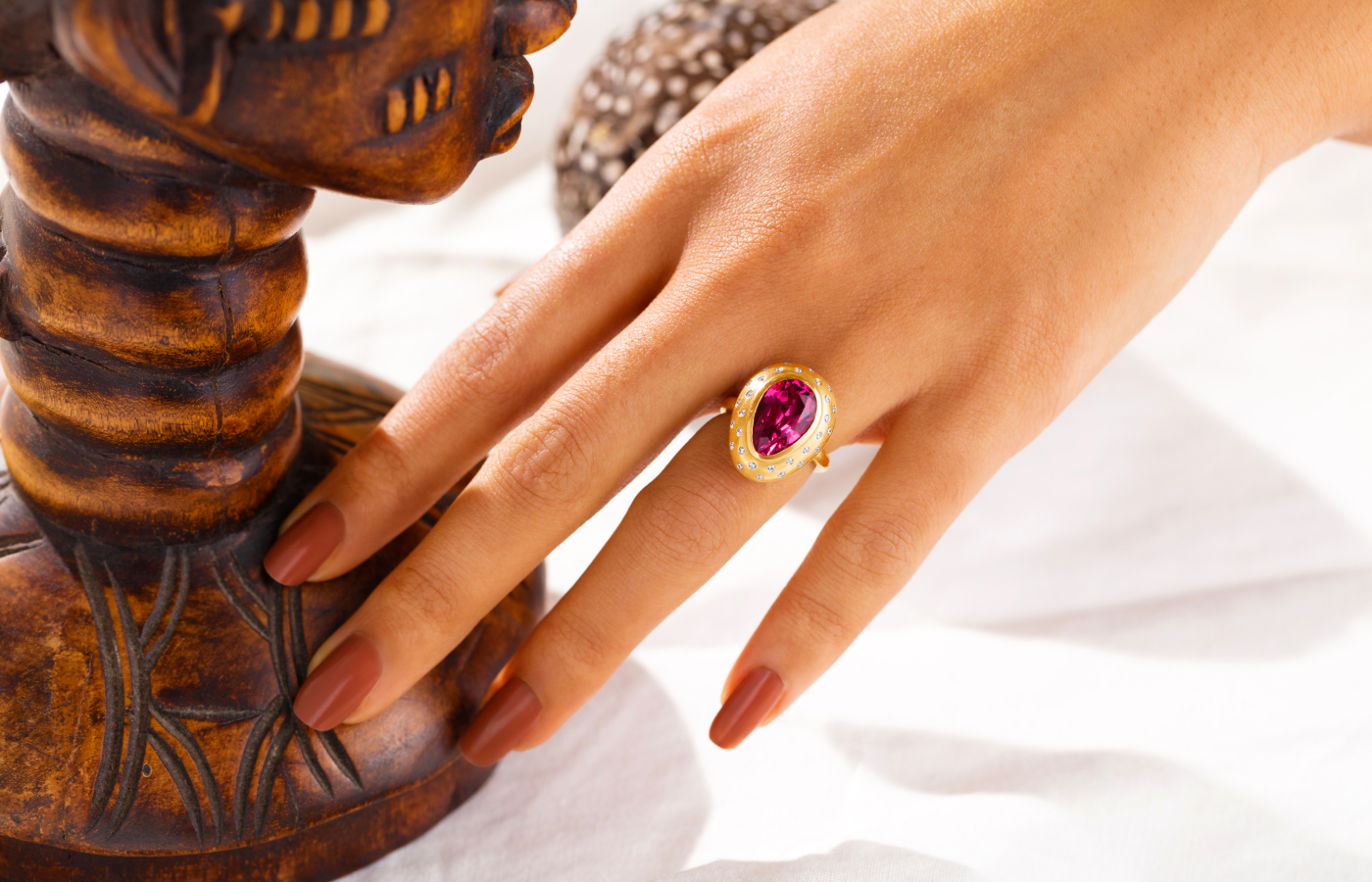
Hailing from the Ortus collection, this egg-shaped ring by Florence Carr symbolises rebirth and renewal with a 6 carat pink spinel from Tajikistan, set in 18k yellow gold
However, I really think our Tafari collection is the perfect example of this. It’s our collection based on the African continent, the landscapes, the people, and the animals, but it was designed to appreciate the history of the Mother Continent, where human life started. Meaning ‘that which inspires awe’ in the East African dialect of Amharic, the ‘Tafari’ collection was the perfect name to blend my love for Africa, tsavorite garnet and safari animals. I was really inspired by the story of the unearthing of the tsavorite garnet and how its discoverer, geologist Campbell Bridges, lived humbly in a Kenyan treehouse while the local leopards drank from the tsavorite-studded bird bath at the bottom of the tree.
It was this story and the blending of nature, precious stones, landscapes, and people that kicked off the idea of connecting our collection with ancient queens and animals. Each is related to either an animal, queen or both. Our Cleopatra double-headed snake ring speaks for itself… as the myth of the Egyptian Queen has historically dictated, she was bitten by an asp in an act of suicide alongside her lover, Mark Anthony. Another example is our ‘Bibi’ Mahenge red spinel shield necklace, named after a revolutionary female activist in Tanzania called Bibi Titi Mohammad. The red spinel represents renewal and rejuvenation, which is exactly what she did in Tanzania, linking the stone, the design and where the stone originated.
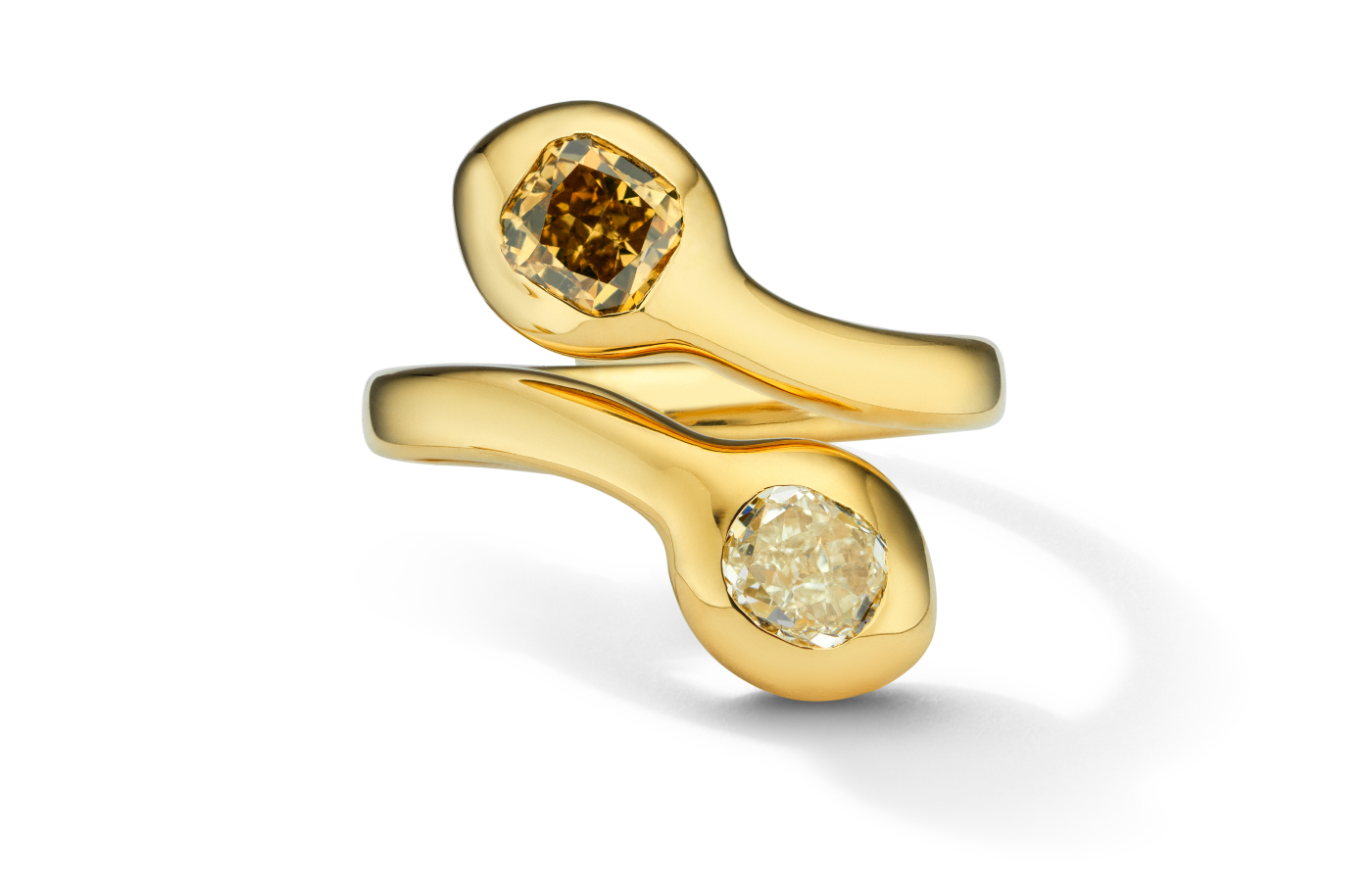
Florence Carr Snake ring from the Tafari collection with a 0.87 carat very light yellow diamond and a 0.88 carat fancy colour cognac diamond, set in 18k yellow gold
KP: Can you share more about your signature necklaces with interchangeable gemstone pendants? How did you develop this design idea?
FC: I have always been in love with big, bold jewellery and ancient cultures. Something that really caught my eye is that the solid gold necklace has lasted millennia throughout cultures all over the world, i.e. collars and torque necklaces. Celtics wore them, as did Scythians, Egyptians and even all the way to Indonesia. However, I really think it’s the simplicity that has helped it stay relevant throughout history. So, that was the first step in creating the signature necklace. However, I realised that it would just look so beautiful with a pendant attached and that kicked off the next step. Each different pendant transforms the necklace into a totally different look, and that was the whole idea. It not only gives the necklace flexibility to suit the occasion and be worn every day, but it makes economic sense, too. Why pay for another big piece of high jewellery when you can achieve the different look you want using the same piece?
KP: Is there a specific gemstone that has captured your imagination recently?
FC: There’s a new phenomenon coming out of the Mahenge (Tanzania) mine, nicknamed ‘milky velvet’ spinel, which is so beautiful. Similar to the ‘milky velvet’ effect of Kashmir sapphires, they really command the same amount of beauty. I recently saw some in Bangkok (courtesy of Lambert Vissot, aka @iamgemhunter) at some extremely large sizes and wow, they were just mesmerising.
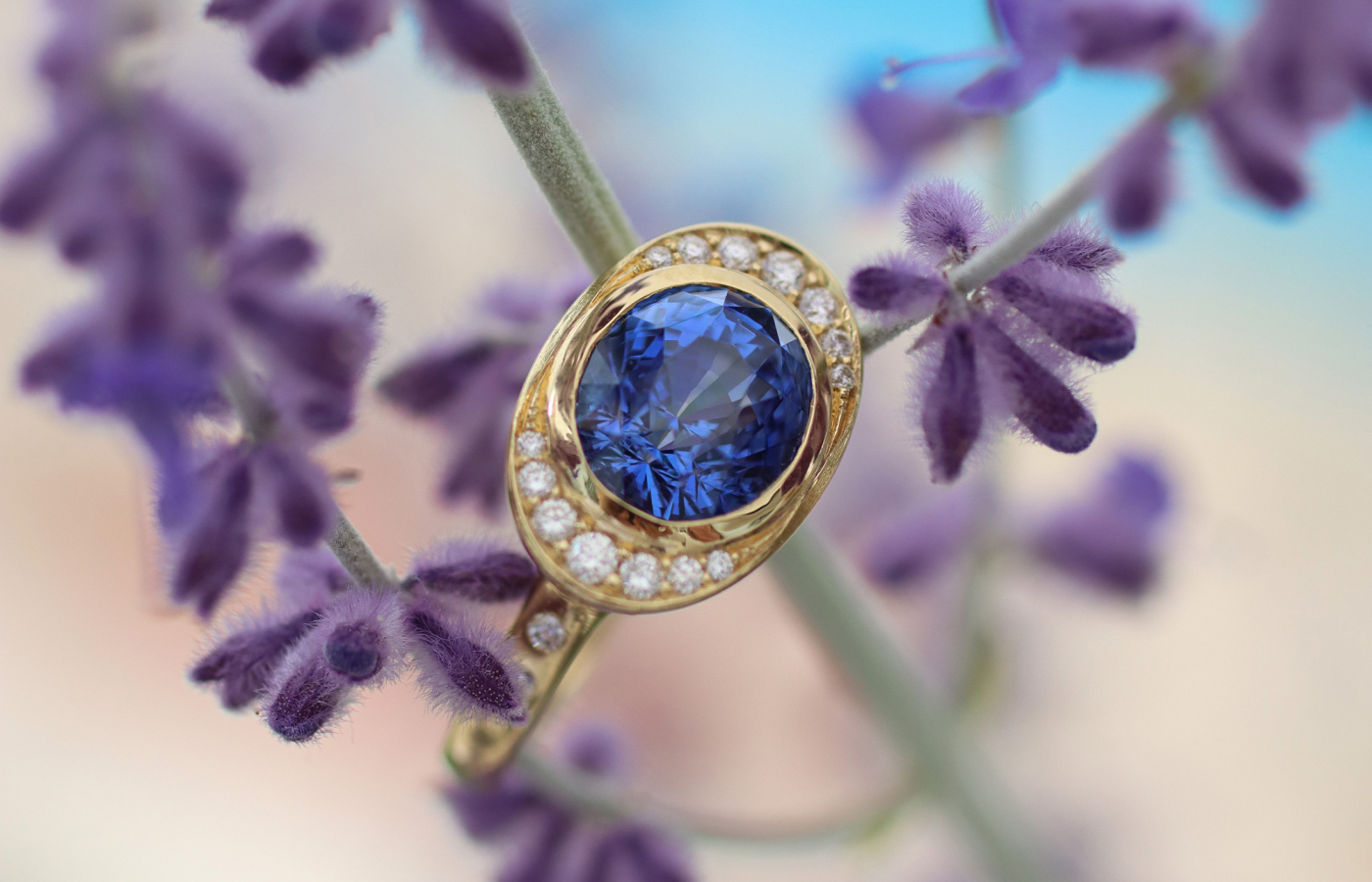
Florence Carr ring with a no-heat cornflower blue Ceylon sapphire of 5.04 carats and round diamonds set in 18k yellow gold
KP: Finally, how do you see the Florence Carr brand evolving, and what are your goals for the coming years?
FC: My main aspiration for the brand is to create a loyal community of individuals who appreciate the art and power of our jewellery, not simply its value, whether monetary, aesthetic, or social. There’s zero exclusivity to our brand or the clientele we want; it’s just our goal to create an environment that is inviting to all but speaks wholeheartedly to a few. I feel that investing in luxury items these days has lost a lot of its previous charm… It’s no longer about how these items make you feel or personal milestones of success; it’s now about competing to prove your social worth. These statements come without judgment because everyone’s personal taste is different, but I feel the pressure of social media has created a desire for branded items that lack soul and character. So, I think that one of our aims is to remain entirely authentic to who we are and the art we create to ensure every piece of our one-of-a-kind jewellery is full of life and lands in the hands of someone who vibes with it energetically and physically.
As our conversation reached its conclusion, Florence assured me that she would continue to focus on large, eye-catching gemstones that stay true to her brand’s ethos of ‘wearable art’. So, whether you’re tempted by a super-sized Mahenge spinel, a valuable demantoid garnet or a quintessential blue sapphire, there’s something in the Florence Carr repertoire that speaks to every taste and temperament.

WORDS
Sarah Jordan has specialised in content writing, editing and branded storytelling for a range of businesses, including De Beers Jewellery, Sotheby’s, the Natural Diamond Council and Gem-A. She is also the founder of her own specialist copywriting business, The William Agency.

Exotic Appeal: A Passion for Rare Gemstones at British Brand Florence Carr
Recently, I had the pleasure of speaking with Florence Carr, who shares my absolute passion for coloured gemstones; the rarer and more exotic, the better! Her self-titled brand, previously known as Flosé, seeks to capture the attention of true individuals who value history, storytelling, art and the culture of gemstones through timeless works of wearable art. I was particularly inspired by a phrase on her website – “Become a flamingo among the flocks of pigeons” – which is a playful way of saying, go on, stand out from the crowd. If you’re looking to make braver and bolder choices with your jewels, consider the confident works of Florence Carr, pictured below, alongside the highlights of our conversation…
Intense, saturated, fiery, deep, bold, vibrant… these are all words we associate with the most brilliantly colourful gemstones. Someone who taps into these characteristics to great effect is Florence Carr, who works alongside her mother to source stones and design timeless, sleek and stylish jewels in London. Through colour, whether that’s mysterious grey, juicy orange or forest green, the brand’s jewellery serves as a transmitter for confidence, allowing the wearer to tap into their “own personal power”. I will admit, it’s hard not to feel energised by fizzing combinations of peridot and blue sapphire, violet-blue spinels and lagoon blue tourmalines, especially when they are set in pieces that can comfortably be worn daily, all year round.

Jewellery designer and gem lover, Florence Carr
We truly believe that beautiful stones speak for themselves… they don’t need dressing up to show that they’re beautiful. We also believe that jewellery is only expensive if it sits in the dresser. We want people to be able to wear our jewellery every day. – Florence Carr
Before I present some of the best bits from my conversation with Florence, I’d like to take a second to dive into the brand’s high jewellery, which centres on a series of necklaces with interchangeable pendants. There are striking bezel-set pear-shaped pink spinel and diamond drops, each weighing over three carats, and a series of Maze pendant styles featuring a 9.78-carat rubellite and a whopping 24.47-carat blue-green tourmaline. I appreciate the unfussy way in which these creations allow the central gemstone to have its moment in the spotlight… much like the aforementioned flamingo! More insights can be found below.

Katerina Perez wears the Florence Carr semi-flexible hinged torque necklace with 3.03 carats of diamonds and the detachable Maze pendant with a 4.2 carat emerald and diamond pavé, while holding the detachable Maze pendant with a 9.78 carat rubellite, all in 18k yellow gold
Katerina Perez: Florence Carr is a family affair and I know your Mum is involved too! How do you go about creating jewellery together?
Florence Carr: Our jewellery-making process starts with a stone, either sourced or given. In-house, we design it and send it to a team in the Goldsmith’s Centre in London, who really do transform these gems into the timeless pieces of art they are. My mother is the gemmologist, and we source the gemstones together. It’s never hard, as we always spot or reach for the same stones! I am primarily the designer and, secondarily, an artist and marketer.
KP: Can you tell me more about your sourcing process? Do you travel to exhibitions or have trusted suppliers that you return to?
FC: My Mum is a gemmologist and has been collecting precious gemstones for decades now. Her love for precious colour gemstones started when she was a child in Nigeria collecting pebbles and stones as her father (and my grandfather) was a geologist for Shell. She has one of the best eyes in the game, and I’ve learned a lot from her. We go to Tucson every year and have all our favourite suppliers there, but now I often visit Bangkok to see them at other times of the year. My Mum has been on trips with Gem-A to Kenya and Tanzania to see the tsavorite garnet mines and buy from women miners in collaboration with ANZA Gems and Gem Legacy. She is also visiting the opal mines in Australia this year with a few other gemmologists.

Florence Carr presents a once-in-a-lifetime Mahenge velvet red spinel of 21 carats, courtesy of Lambert Vissot (aka @iamgemhunter)
KP: Colours often carry deep meanings in jewellery. How do you select gemstones from such a wealth of minerals?
FC: Historically, the colours of gemstones have been used to help dictate their energetic meanings, such as ruby red being a symbol of love and passion. However, I tend to choose gemstone colours to evoke specific emotions based on where I see that gemstone and piece of jewellery being worn or connected to. For example, I envisage our bright, sparkly blue zircon cocktail ring being worn in a sunny beach environment by the water or on a yacht sparkling in the sun. Whereas something like our grey spinel drop earrings I see as being worn somewhere like the UK… they have colour and life to them, yet as a culture we have much more of an understated aesthetic (and weather to match!) so more muted colours suit the British taste and values more. Although I try to create colour combinations that would appeal to anybody, no matter their race, ethnicity or origin, I love to visualise the sort of person wearing my jewellery.

Katerina Perez wears a Florence Carr cocktail ring with an 11.92 carat blue zircon and diamonds accents, set in 18k yellow gold
KP: How do you incorporate spirituality, myths, legends and the raw energy of precious stones into your designs?
FC: I studied Religion, Politics and Ancient History at the University in Cape Town, and I have always had a longstanding fascination with how everything is connected, underpinned by universal energies and religions, whether you believe in spirituality or follow a religion yourself. The same shapes and symbols underpin our lives on a daily basis and have existed and been worshipped in diverse myths from civilisations all thousands of miles apart, so I really wanted to reflect and honour these beacons of power in our jewellery. For example, in our ‘Ortus’ collection, which we started when the UK started to emerge from post-pandemic life, we wanted to use the universal symbol of the ‘egg’, which has been used to celebrate renewal and rebirth of life into a new reality throughout history. So, we used egg-shaped stones to create the collection.

Hailing from the Ortus collection, this egg-shaped ring by Florence Carr symbolises rebirth and renewal with a 6 carat pink spinel from Tajikistan, set in 18k yellow gold
However, I really think our Tafari collection is the perfect example of this. It’s our collection based on the African continent, the landscapes, the people, and the animals, but it was designed to appreciate the history of the Mother Continent, where human life started. Meaning ‘that which inspires awe’ in the East African dialect of Amharic, the ‘Tafari’ collection was the perfect name to blend my love for Africa, tsavorite garnet and safari animals. I was really inspired by the story of the unearthing of the tsavorite garnet and how its discoverer, geologist Campbell Bridges, lived humbly in a Kenyan treehouse while the local leopards drank from the tsavorite-studded bird bath at the bottom of the tree.
It was this story and the blending of nature, precious stones, landscapes, and people that kicked off the idea of connecting our collection with ancient queens and animals. Each is related to either an animal, queen or both. Our Cleopatra double-headed snake ring speaks for itself… as the myth of the Egyptian Queen has historically dictated, she was bitten by an asp in an act of suicide alongside her lover, Mark Anthony. Another example is our ‘Bibi’ Mahenge red spinel shield necklace, named after a revolutionary female activist in Tanzania called Bibi Titi Mohammad. The red spinel represents renewal and rejuvenation, which is exactly what she did in Tanzania, linking the stone, the design and where the stone originated.

Florence Carr Snake ring from the Tafari collection with a 0.87 carat very light yellow diamond and a 0.88 carat fancy colour cognac diamond, set in 18k yellow gold
KP: Can you share more about your signature necklaces with interchangeable gemstone pendants? How did you develop this design idea?
FC: I have always been in love with big, bold jewellery and ancient cultures. Something that really caught my eye is that the solid gold necklace has lasted millennia throughout cultures all over the world, i.e. collars and torque necklaces. Celtics wore them, as did Scythians, Egyptians and even all the way to Indonesia. However, I really think it’s the simplicity that has helped it stay relevant throughout history. So, that was the first step in creating the signature necklace. However, I realised that it would just look so beautiful with a pendant attached and that kicked off the next step. Each different pendant transforms the necklace into a totally different look, and that was the whole idea. It not only gives the necklace flexibility to suit the occasion and be worn every day, but it makes economic sense, too. Why pay for another big piece of high jewellery when you can achieve the different look you want using the same piece?
KP: Is there a specific gemstone that has captured your imagination recently?
FC: There’s a new phenomenon coming out of the Mahenge (Tanzania) mine, nicknamed ‘milky velvet’ spinel, which is so beautiful. Similar to the ‘milky velvet’ effect of Kashmir sapphires, they really command the same amount of beauty. I recently saw some in Bangkok (courtesy of Lambert Vissot, aka @iamgemhunter) at some extremely large sizes and wow, they were just mesmerising.

Florence Carr ring with a no-heat cornflower blue Ceylon sapphire of 5.04 carats and round diamonds set in 18k yellow gold
KP: Finally, how do you see the Florence Carr brand evolving, and what are your goals for the coming years?
FC: My main aspiration for the brand is to create a loyal community of individuals who appreciate the art and power of our jewellery, not simply its value, whether monetary, aesthetic, or social. There’s zero exclusivity to our brand or the clientele we want; it’s just our goal to create an environment that is inviting to all but speaks wholeheartedly to a few. I feel that investing in luxury items these days has lost a lot of its previous charm… It’s no longer about how these items make you feel or personal milestones of success; it’s now about competing to prove your social worth. These statements come without judgment because everyone’s personal taste is different, but I feel the pressure of social media has created a desire for branded items that lack soul and character. So, I think that one of our aims is to remain entirely authentic to who we are and the art we create to ensure every piece of our one-of-a-kind jewellery is full of life and lands in the hands of someone who vibes with it energetically and physically.
As our conversation reached its conclusion, Florence assured me that she would continue to focus on large, eye-catching gemstones that stay true to her brand’s ethos of ‘wearable art’. So, whether you’re tempted by a super-sized Mahenge spinel, a valuable demantoid garnet or a quintessential blue sapphire, there’s something in the Florence Carr repertoire that speaks to every taste and temperament.

WORDS
Sarah Jordan has specialised in content writing, editing and branded storytelling for a range of businesses, including De Beers Jewellery, Sotheby’s, the Natural Diamond Council and Gem-A. She is also the founder of her own specialist copywriting business, The William Agency.
